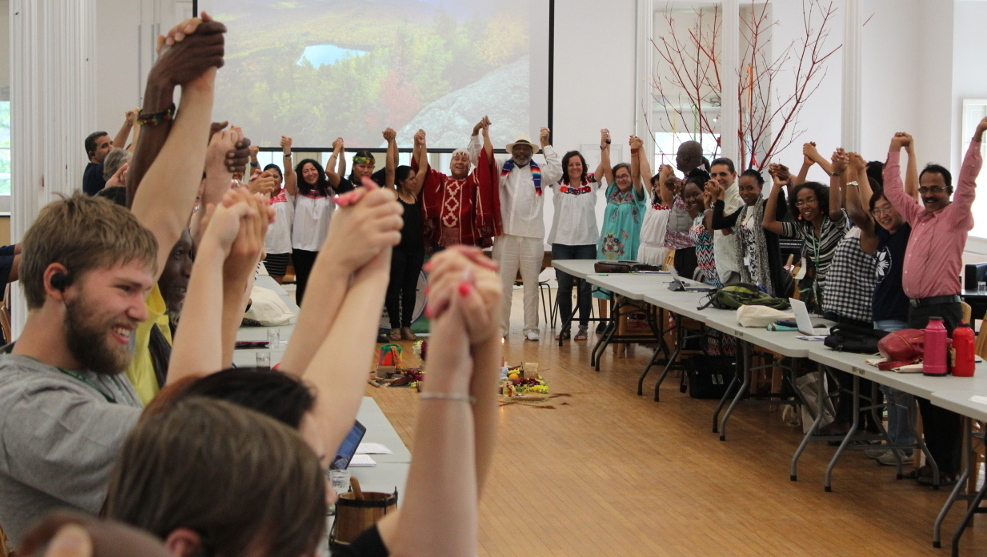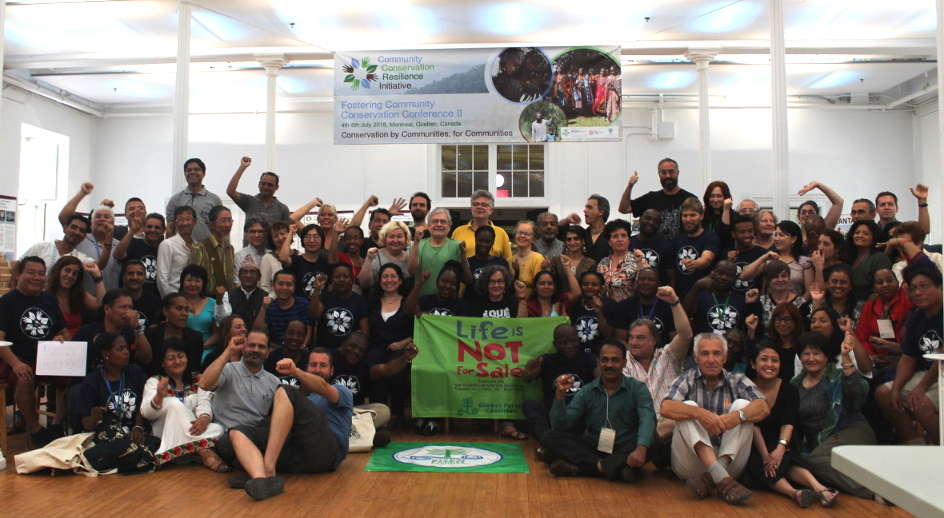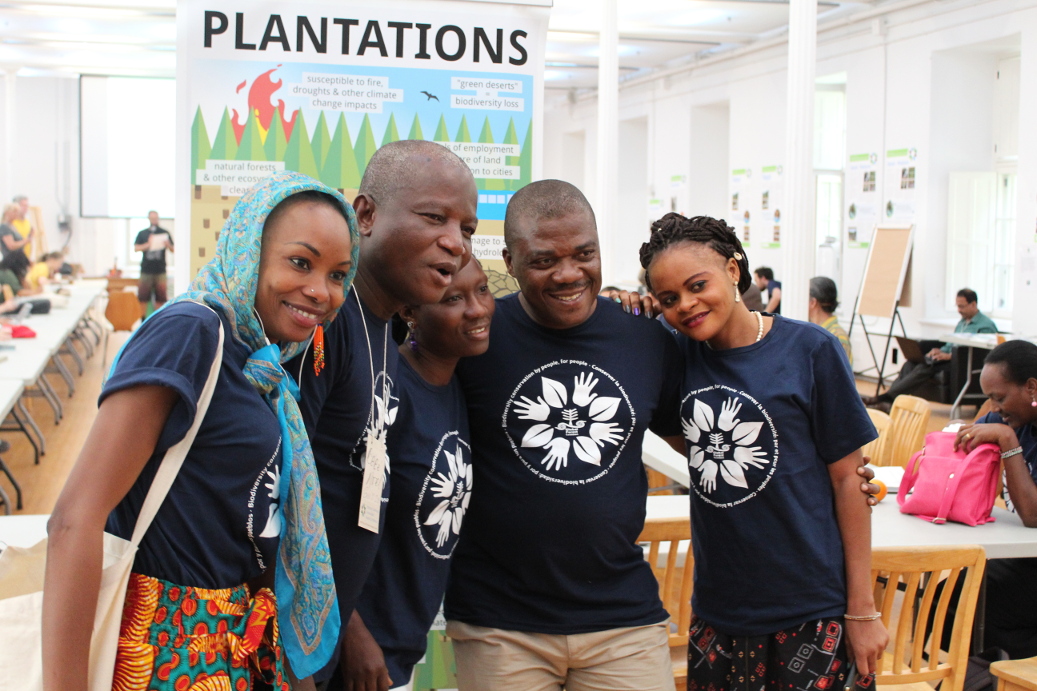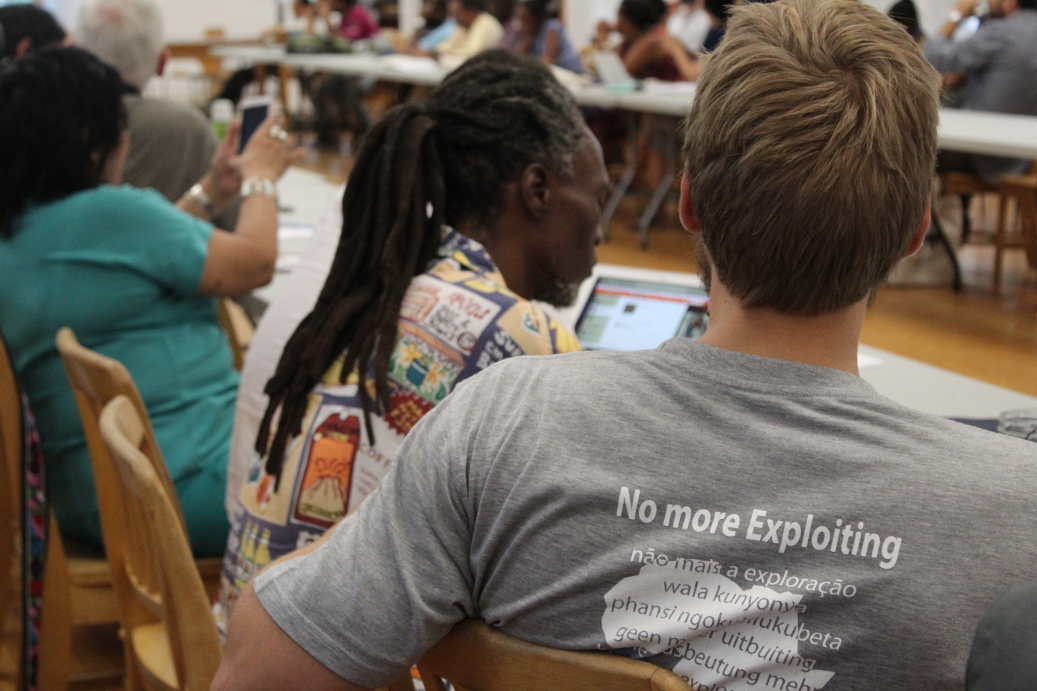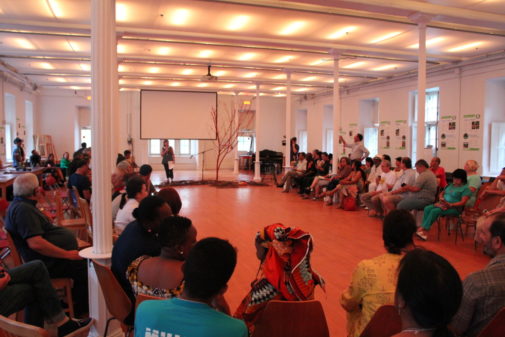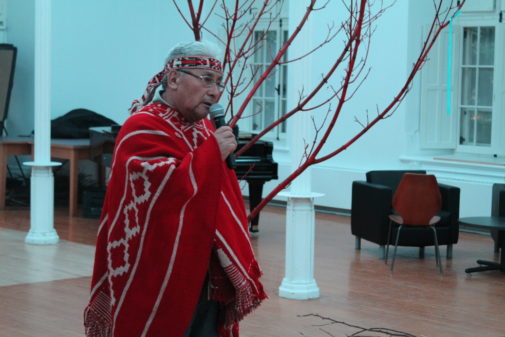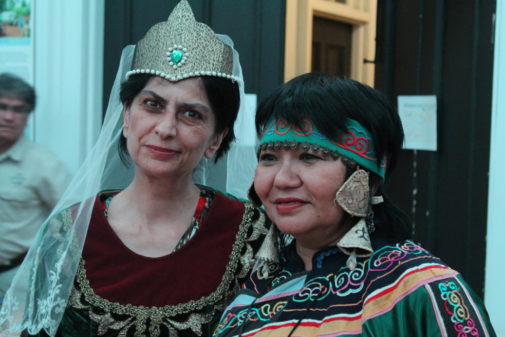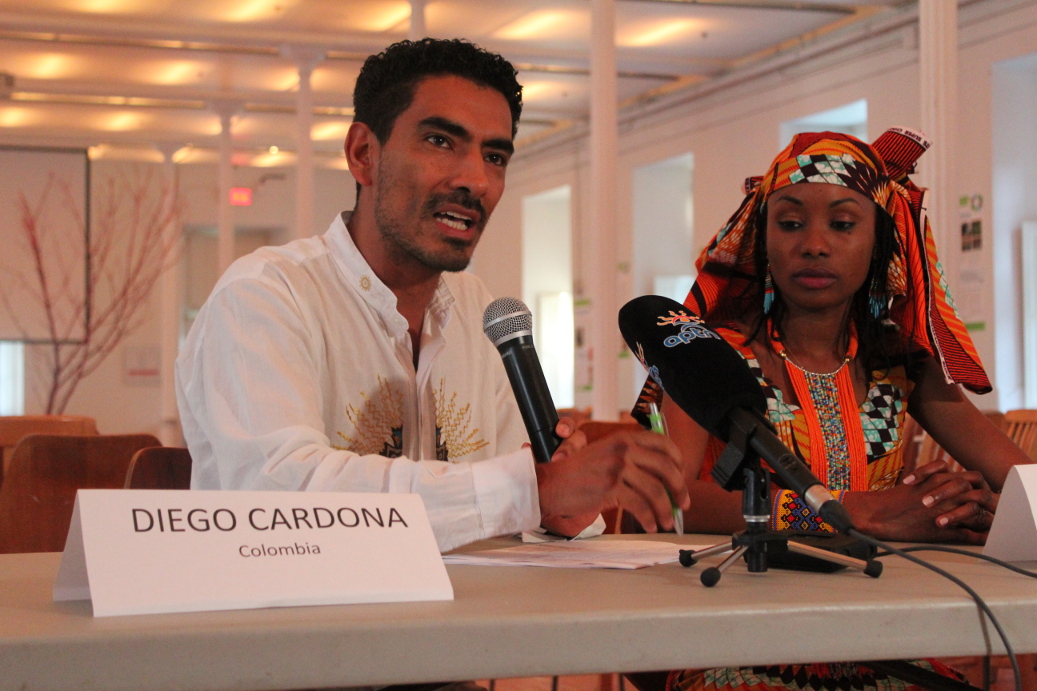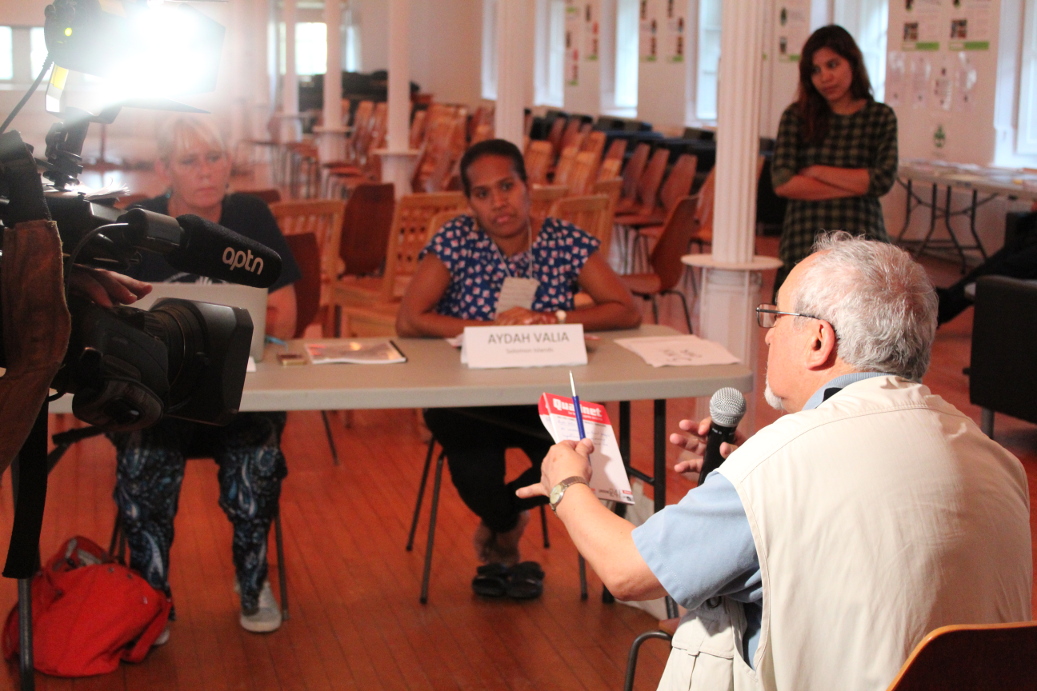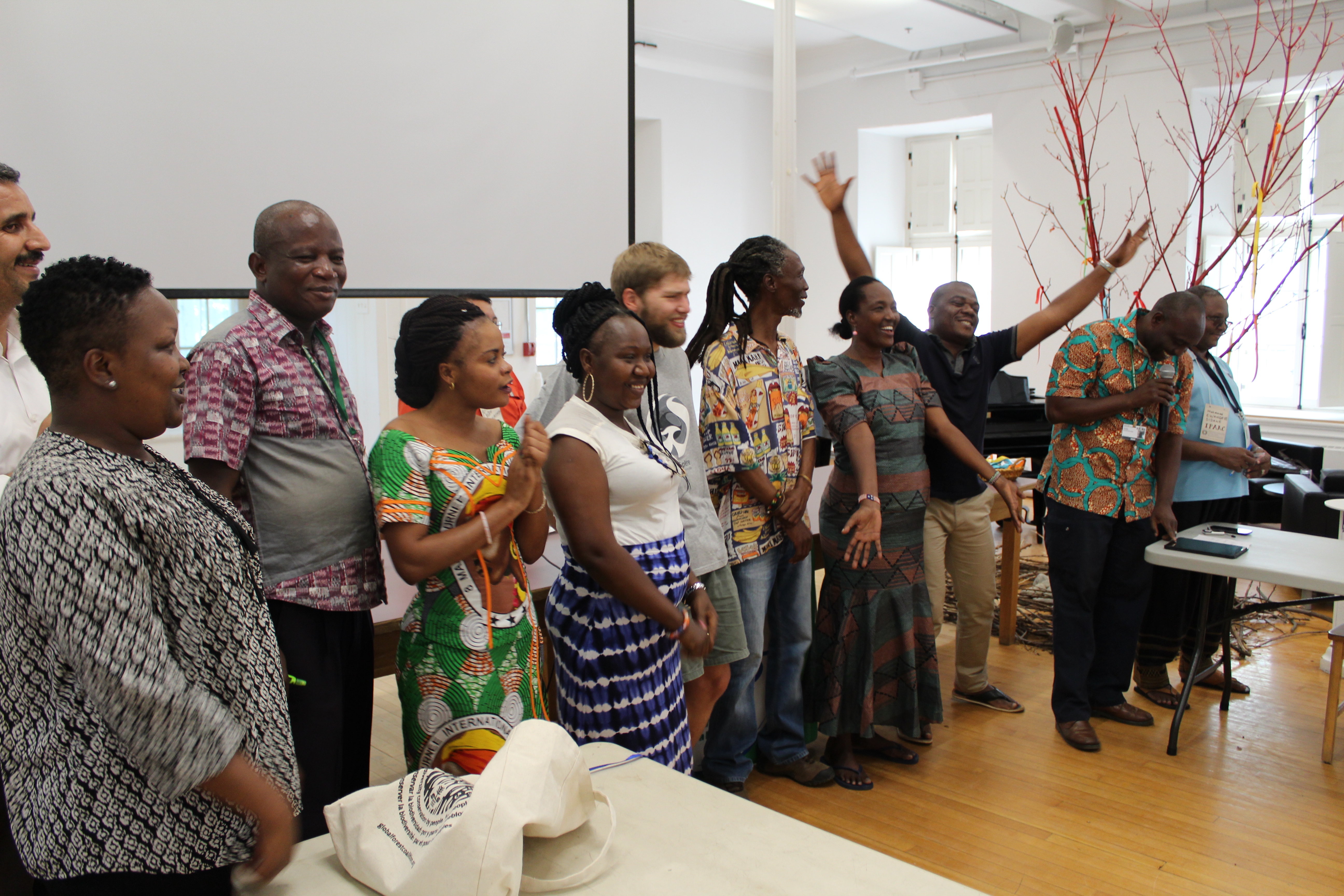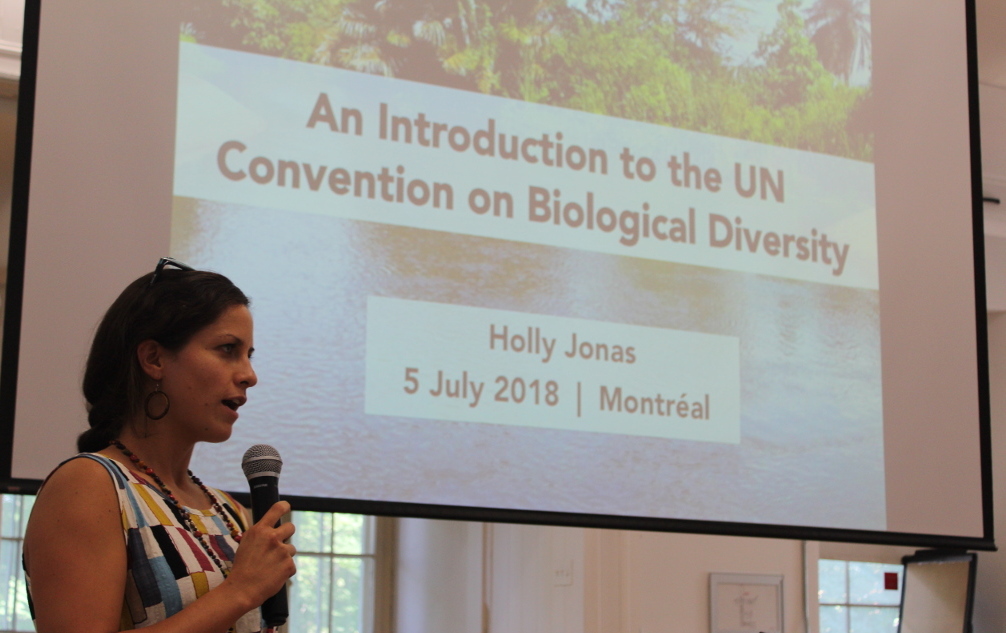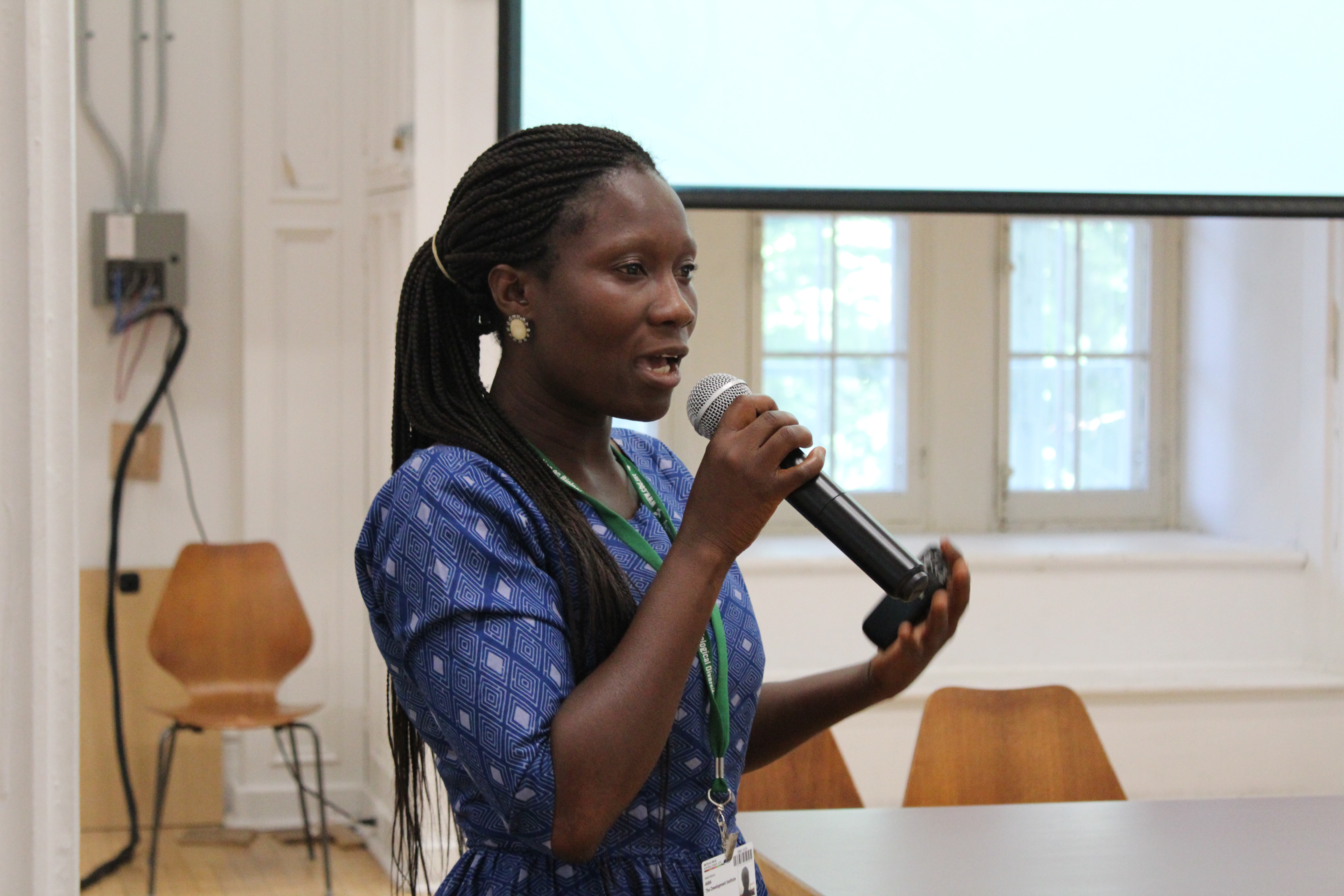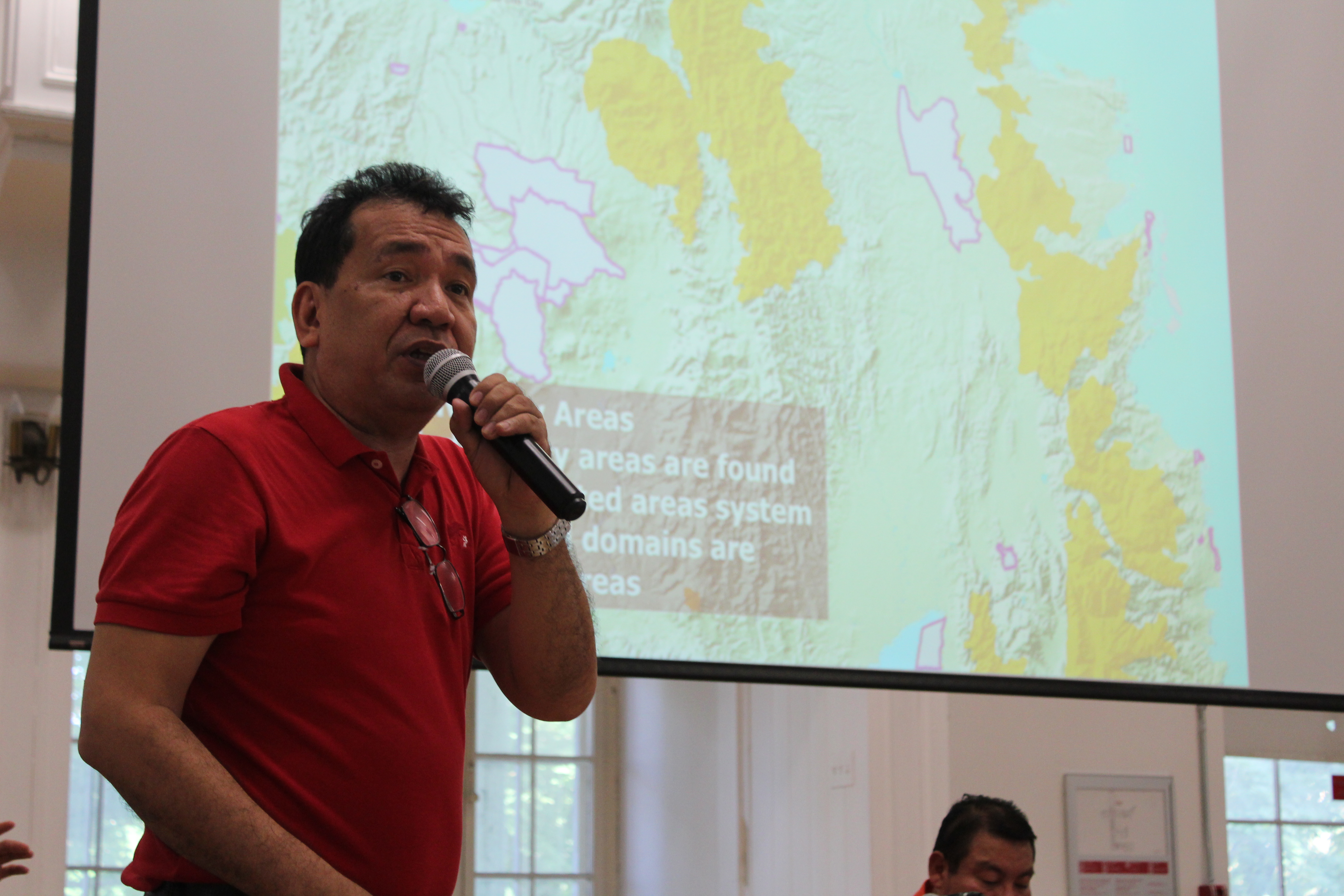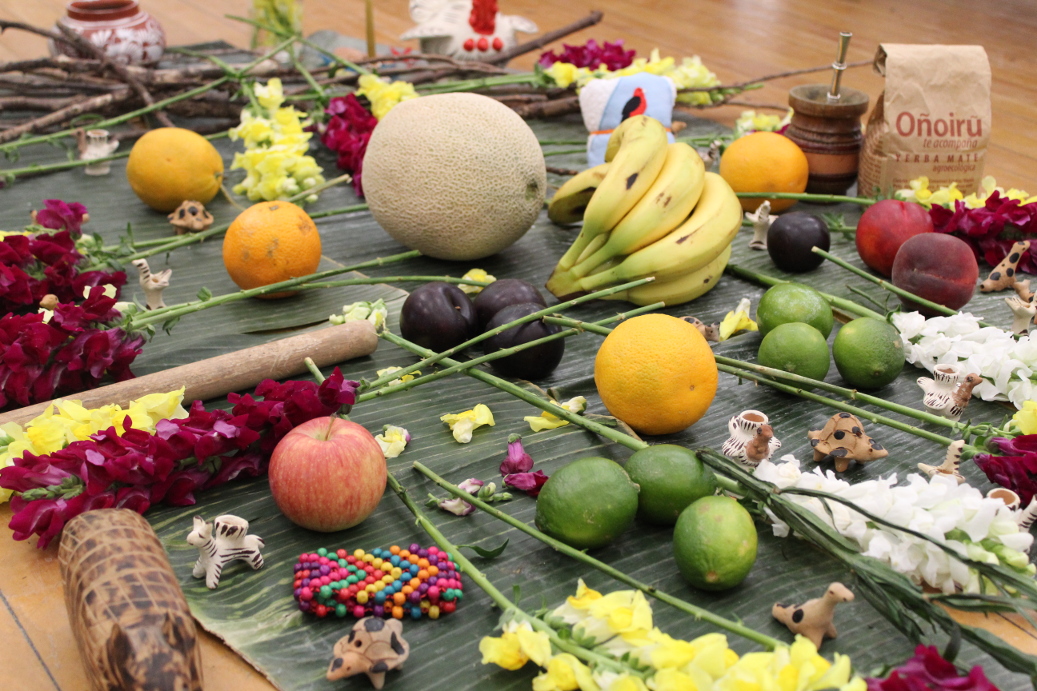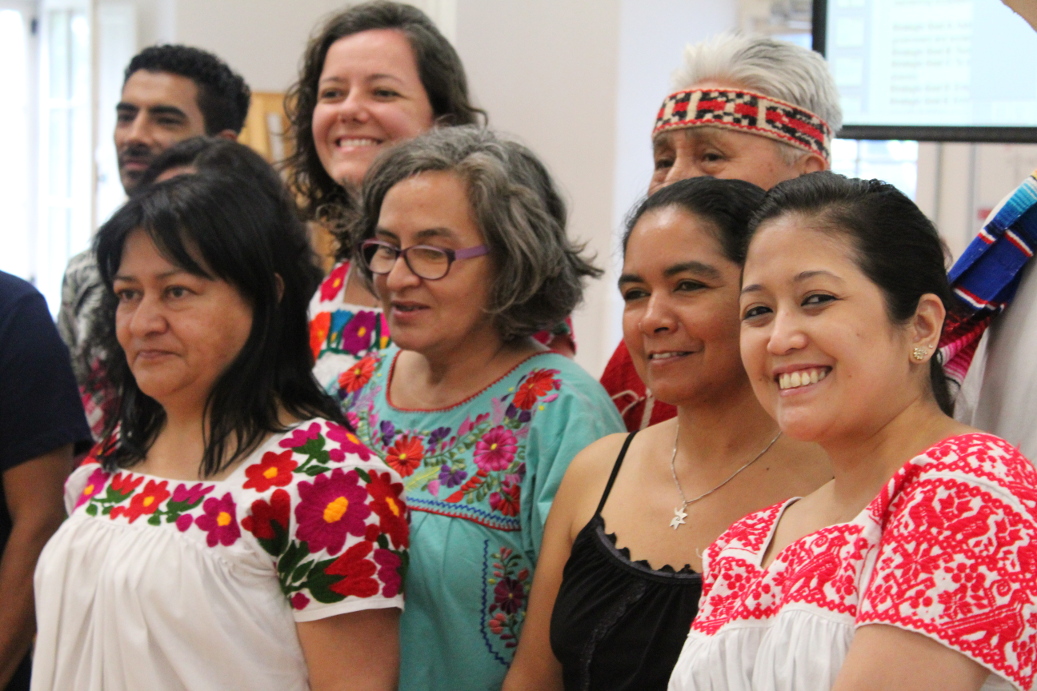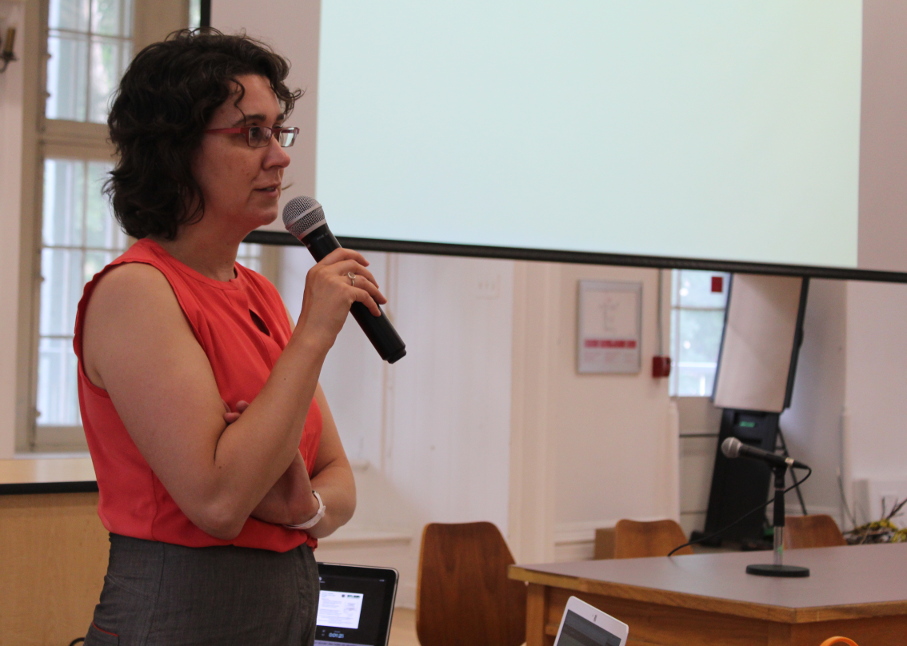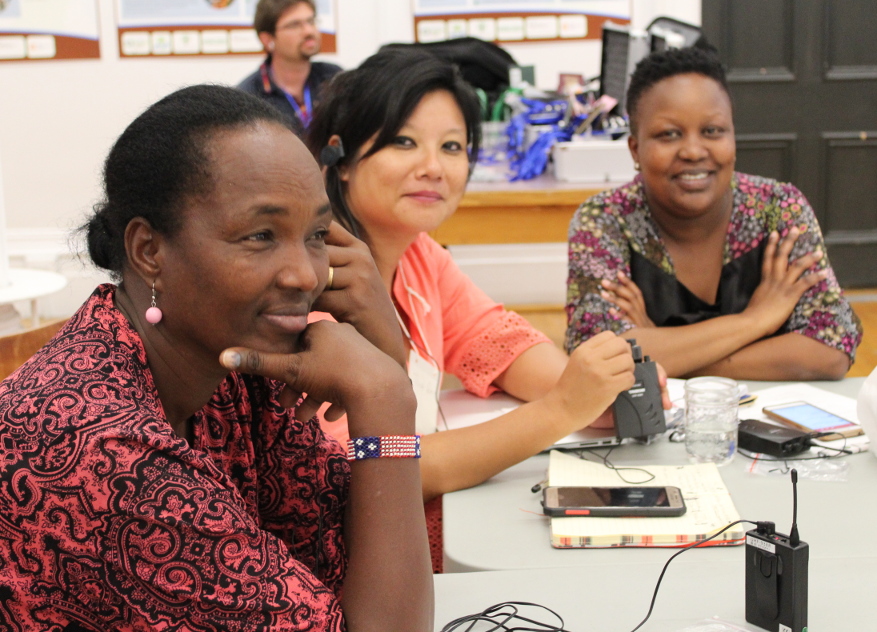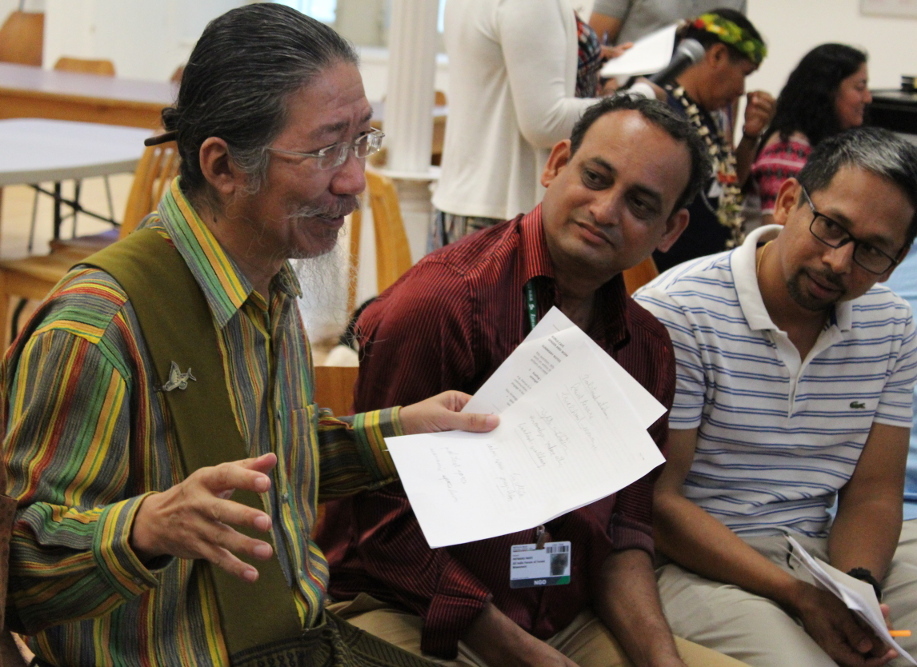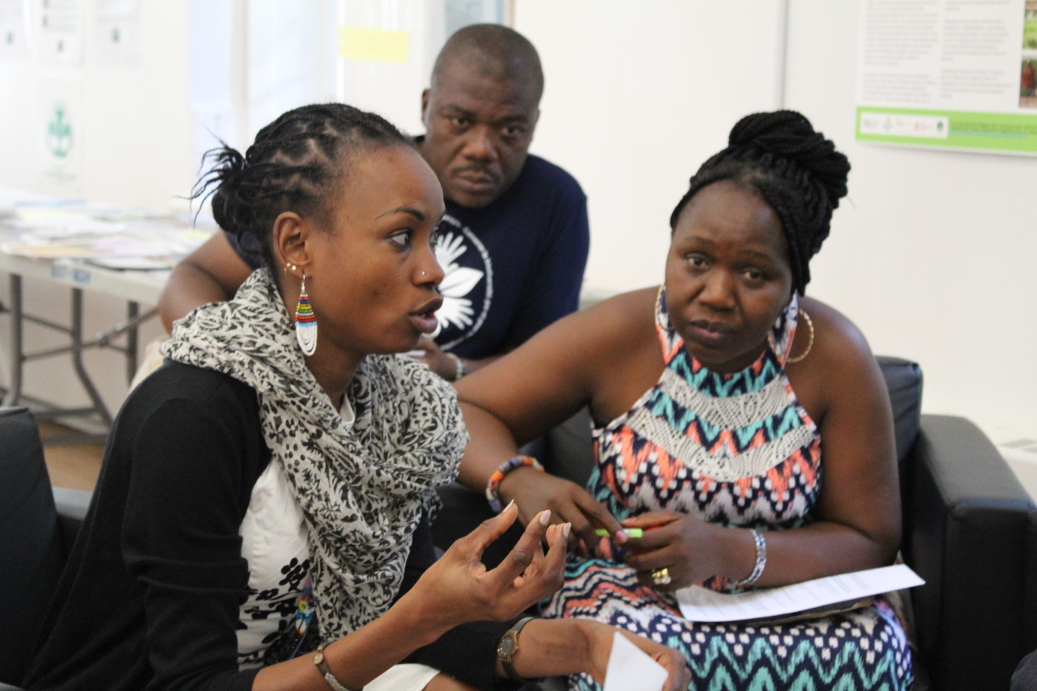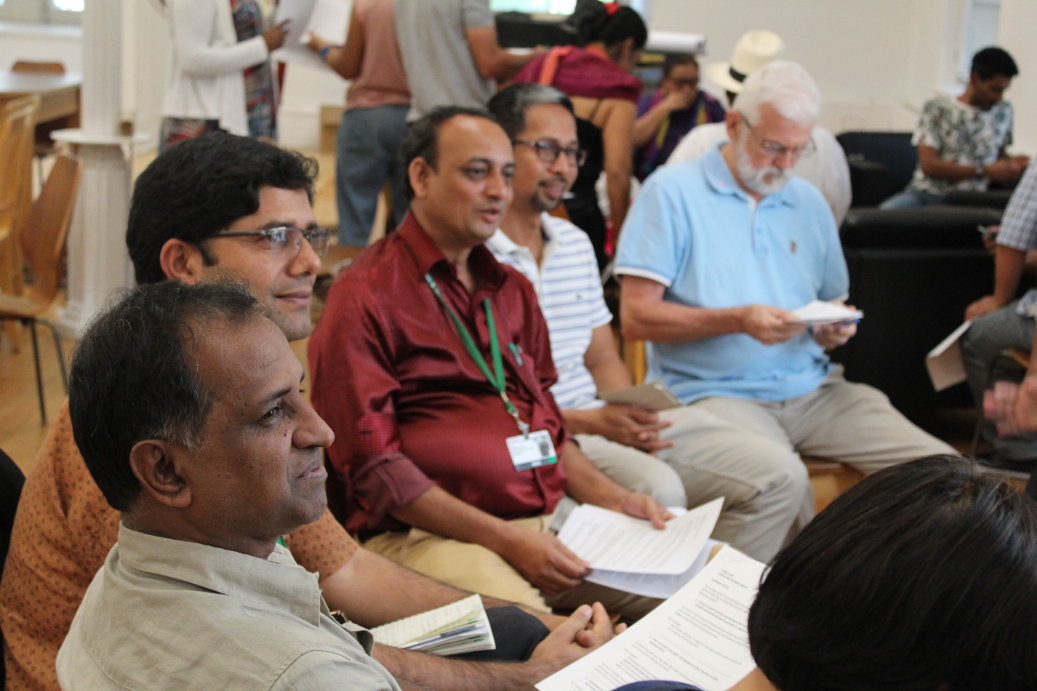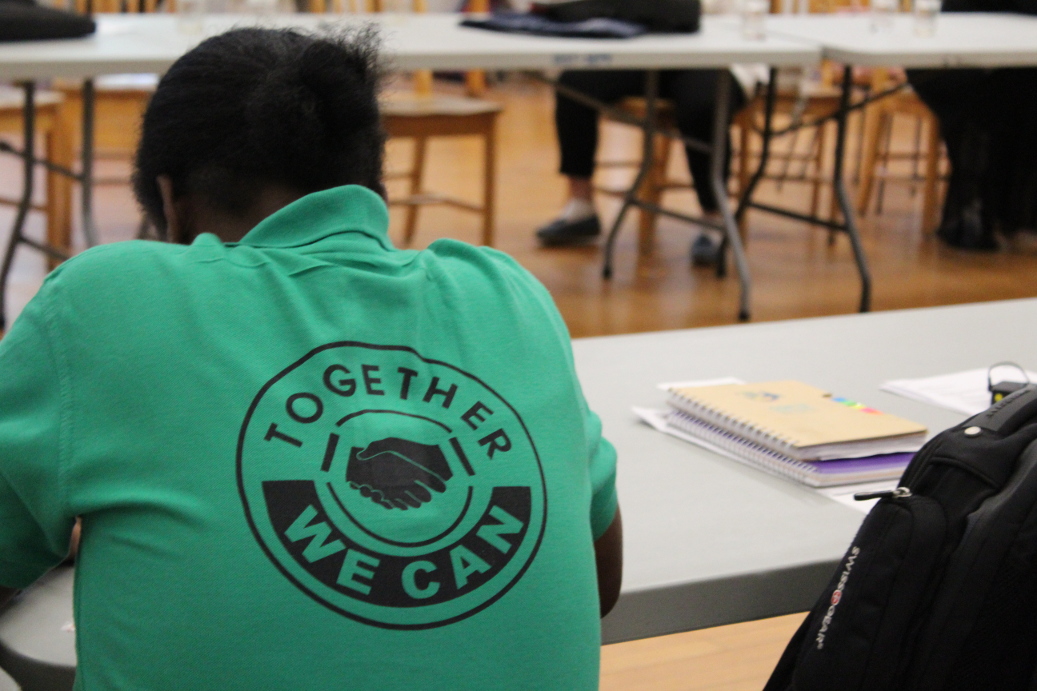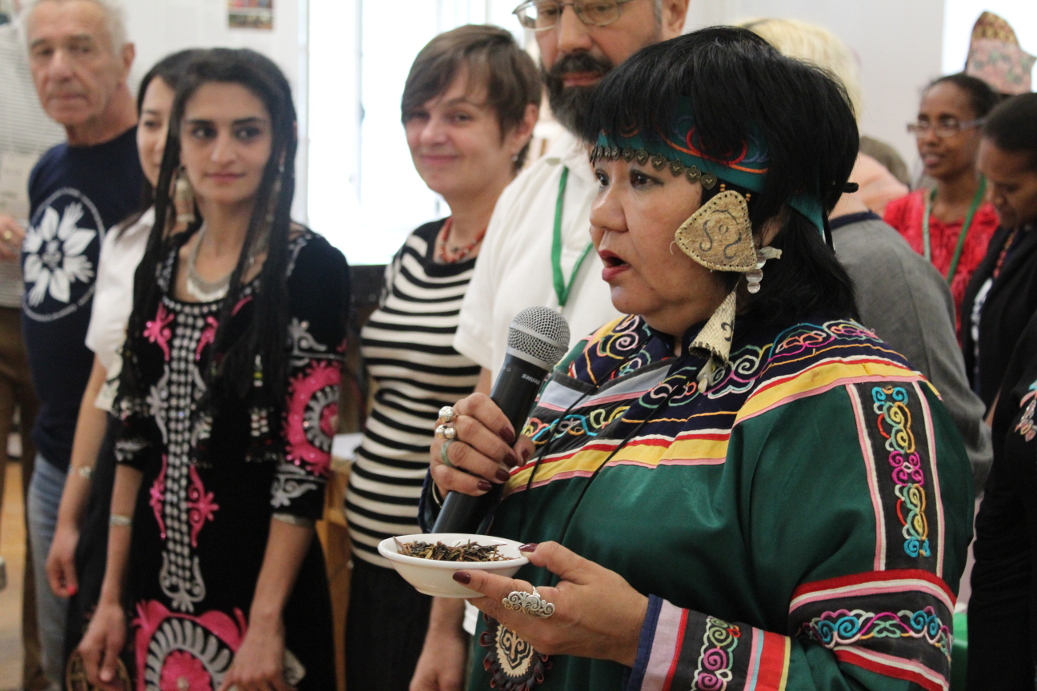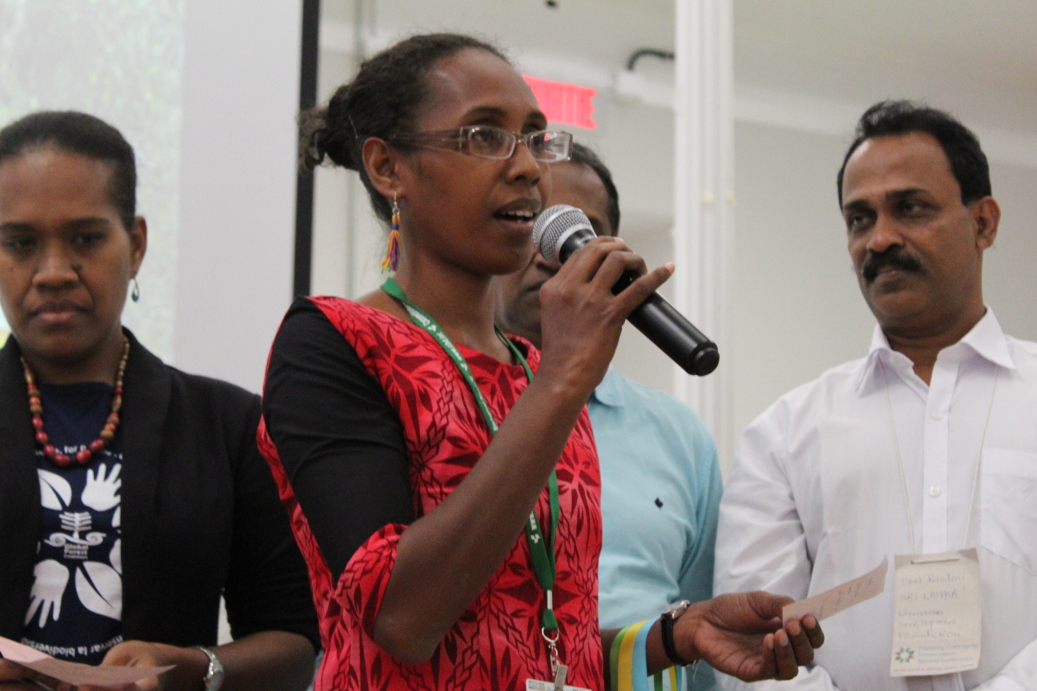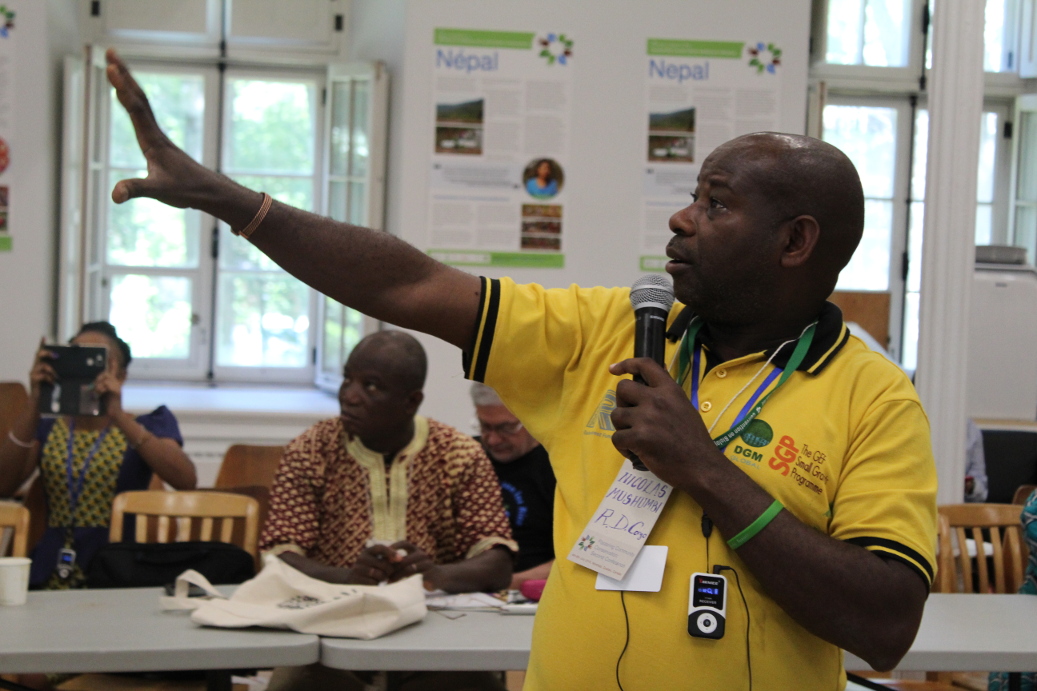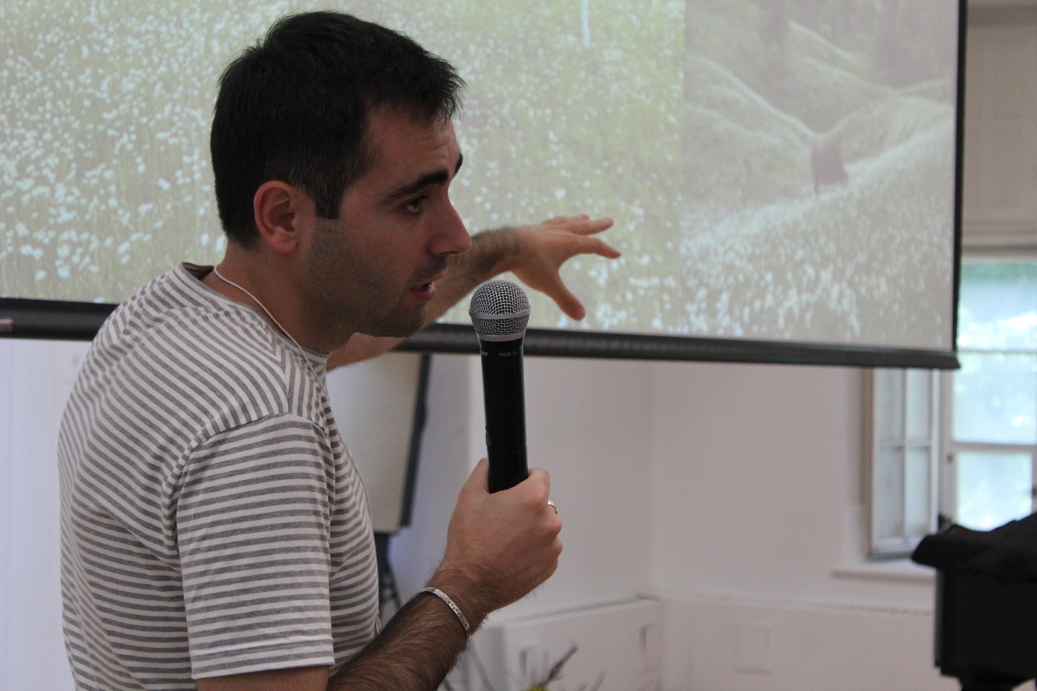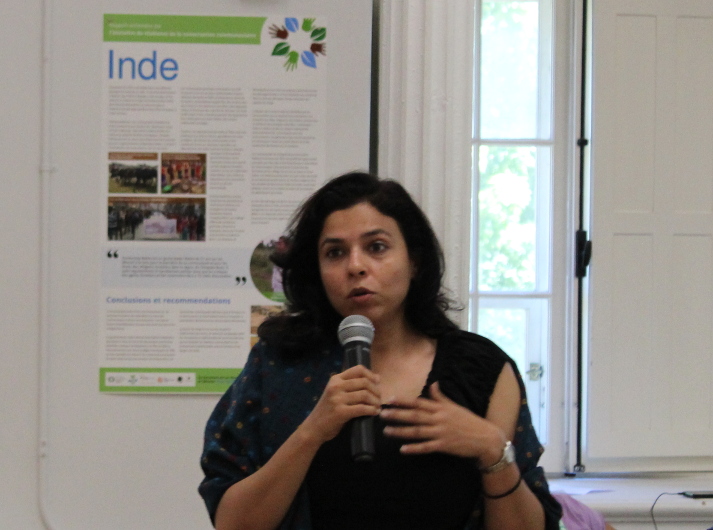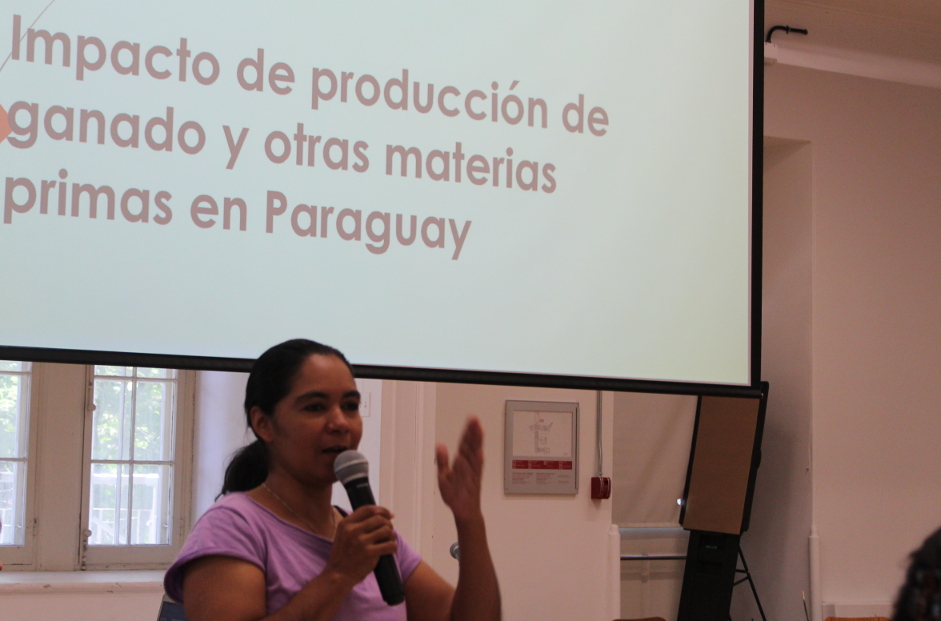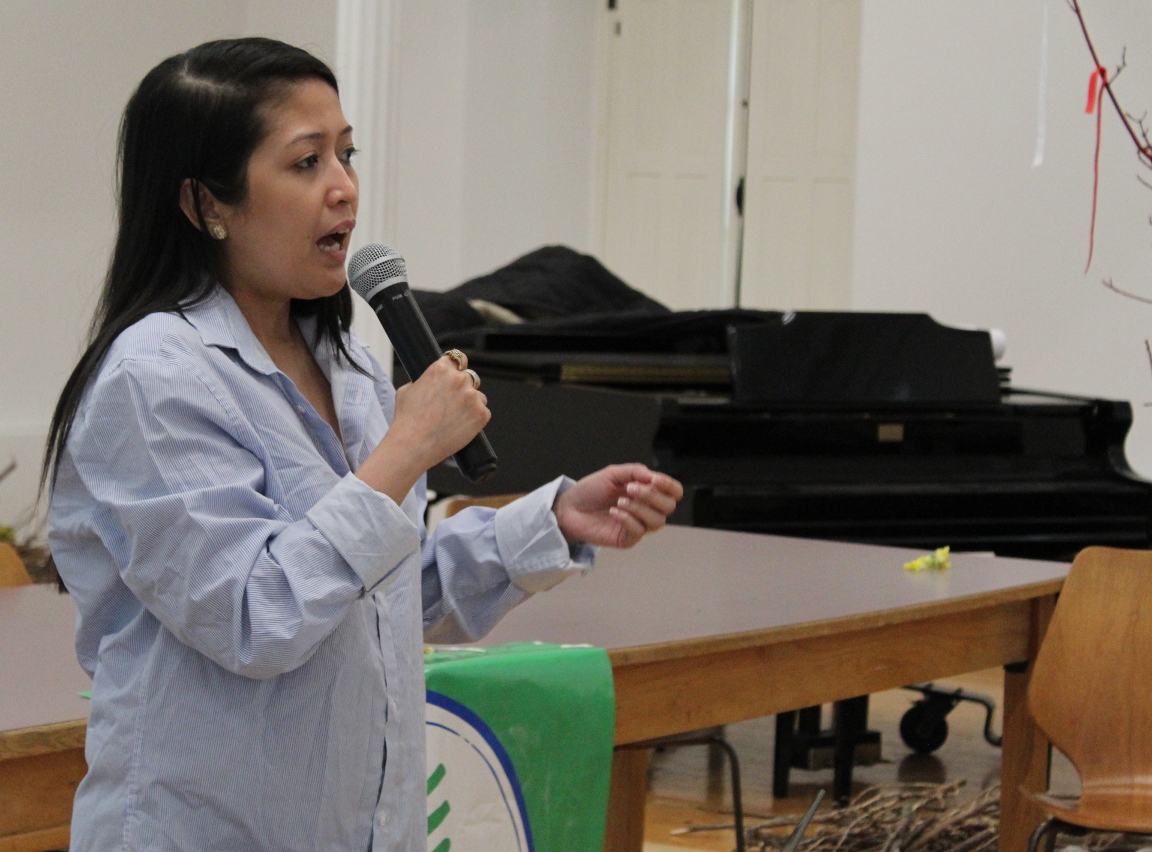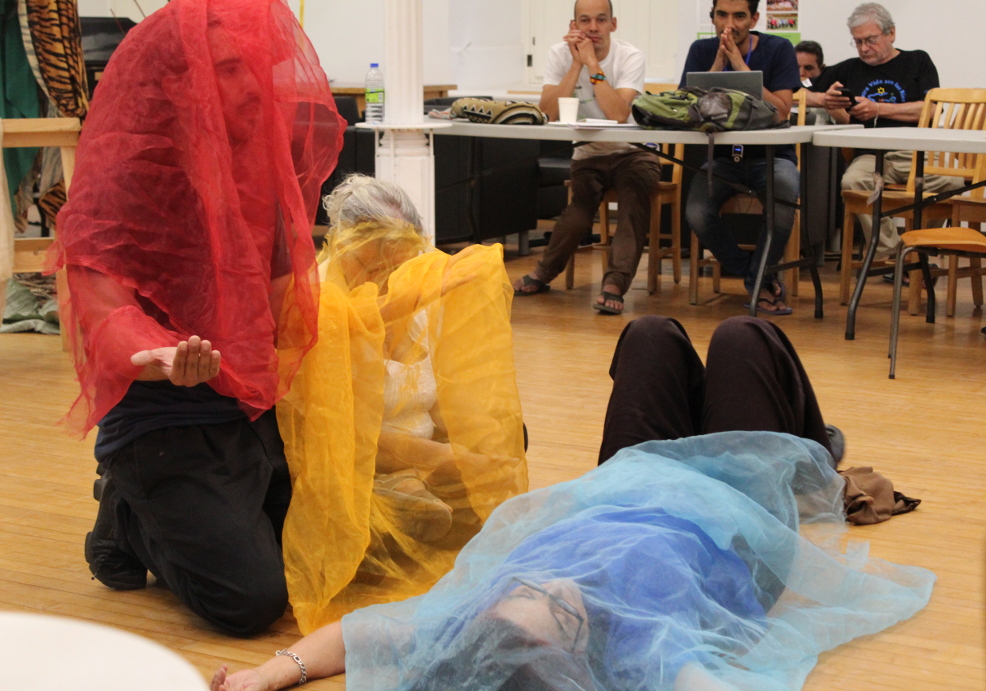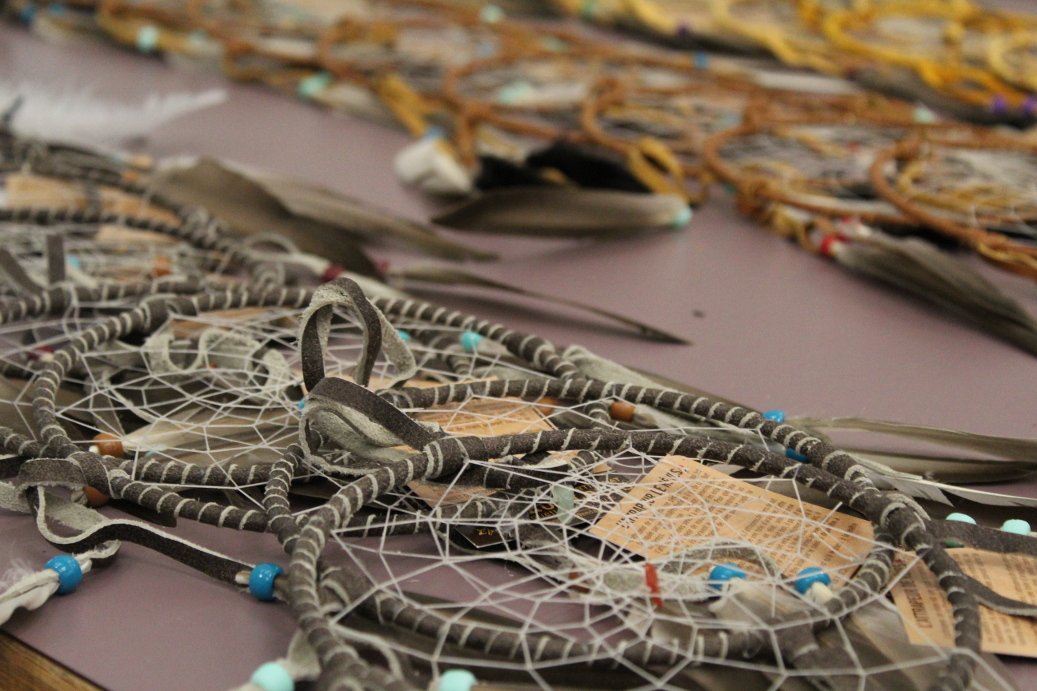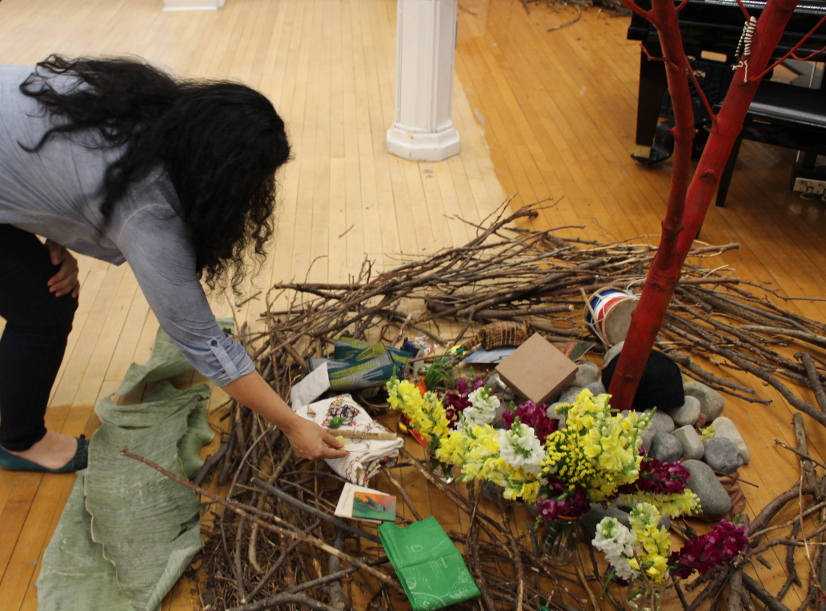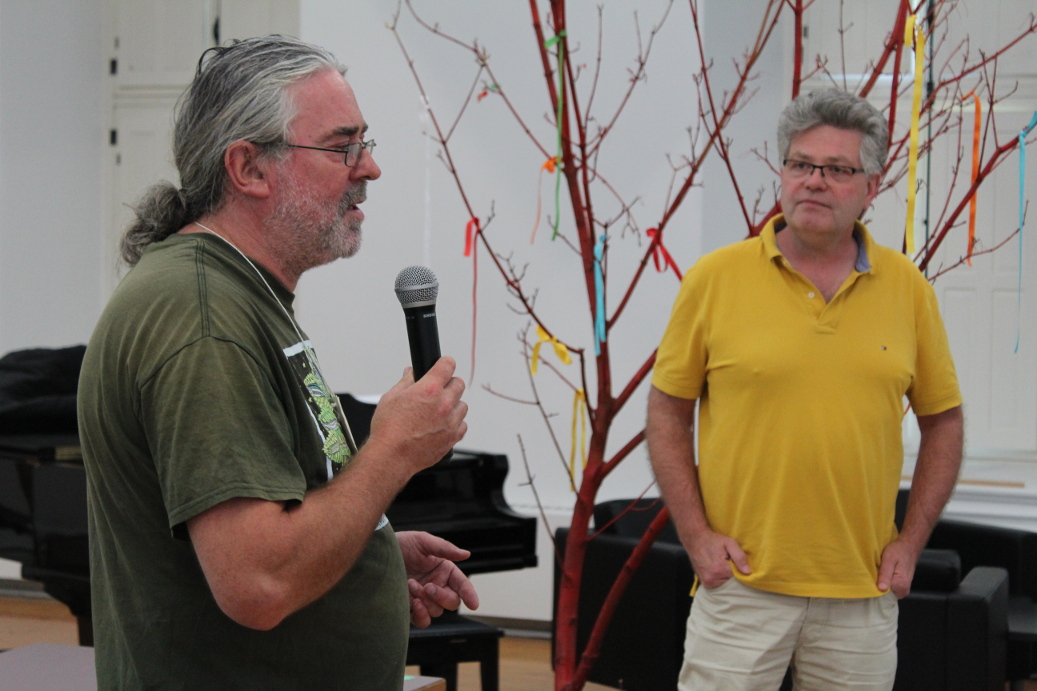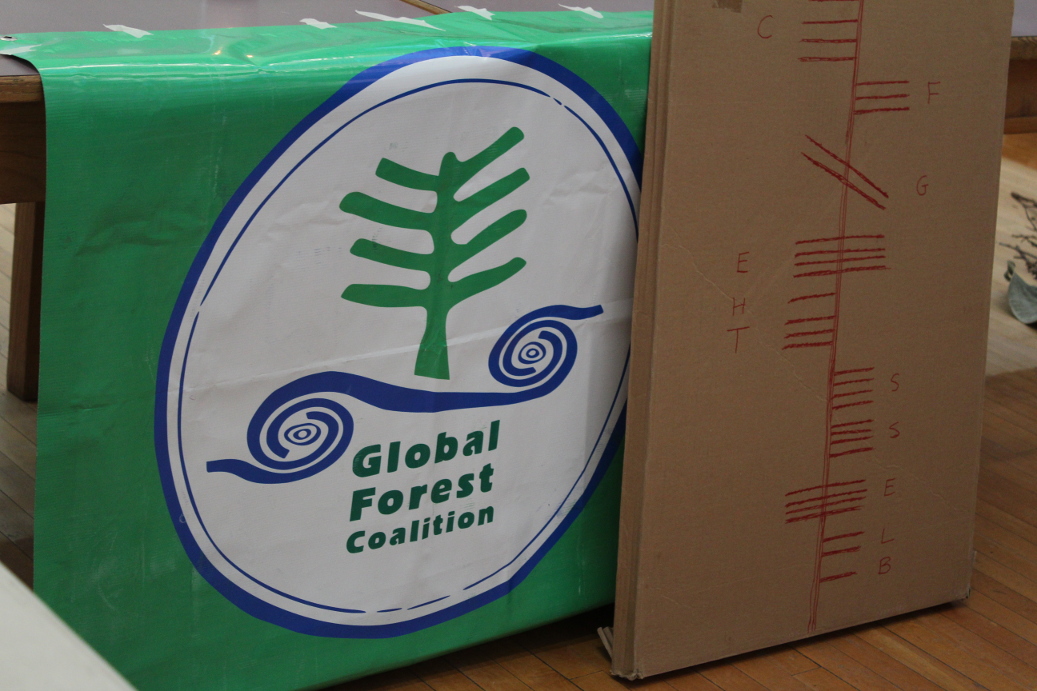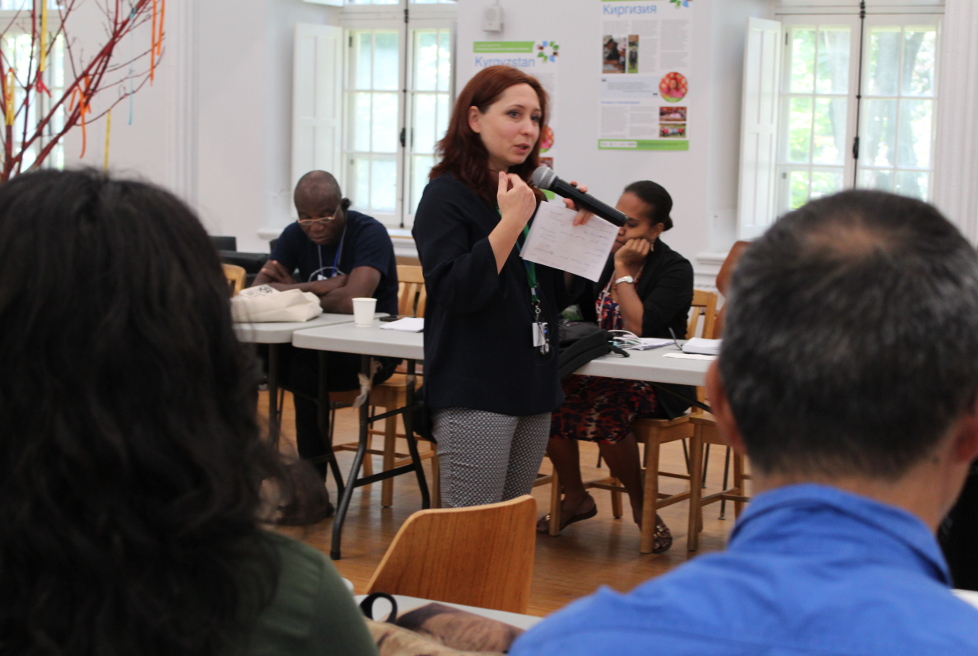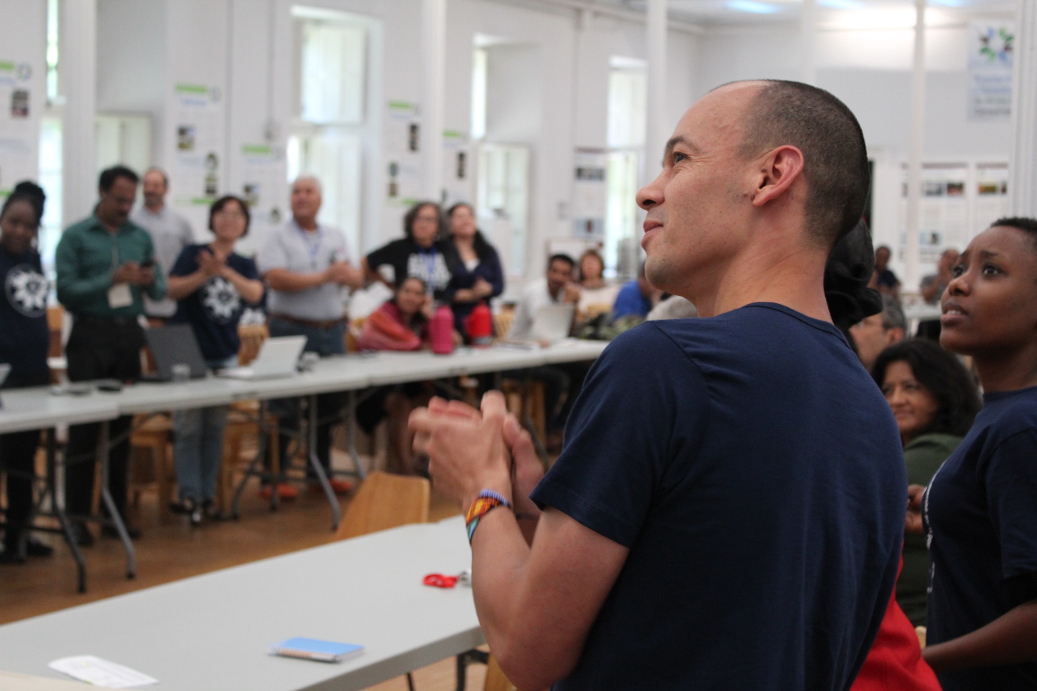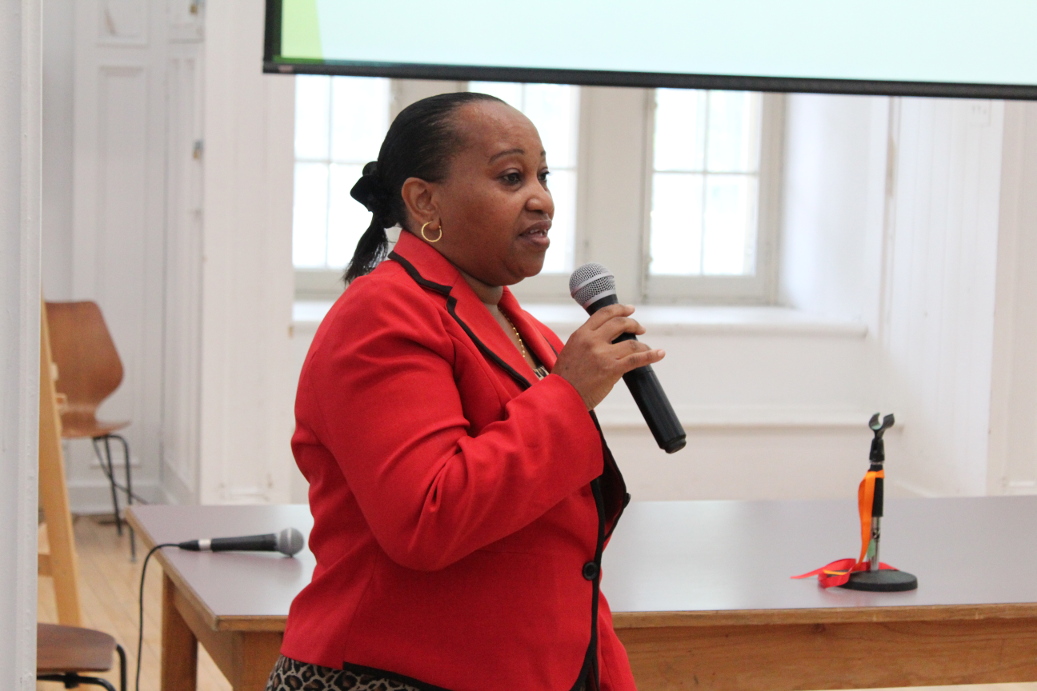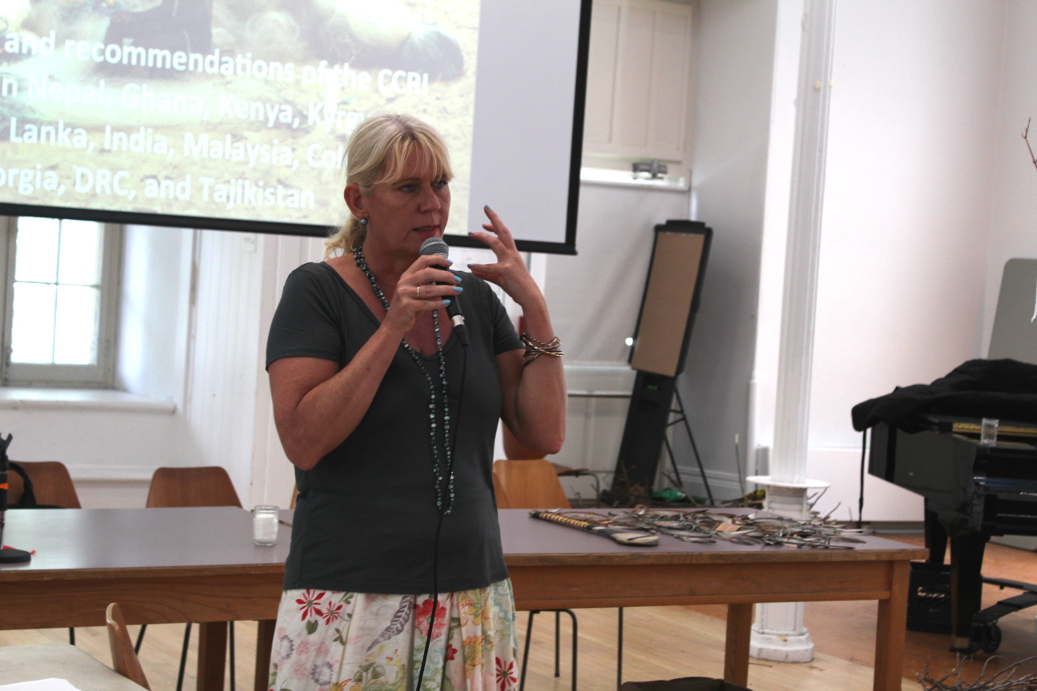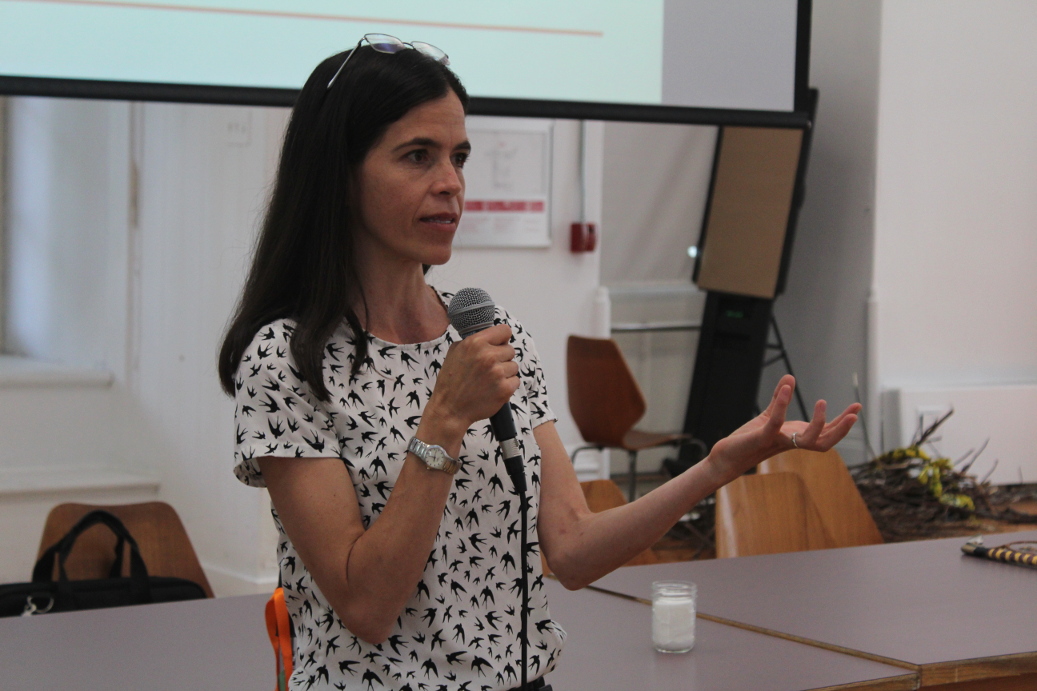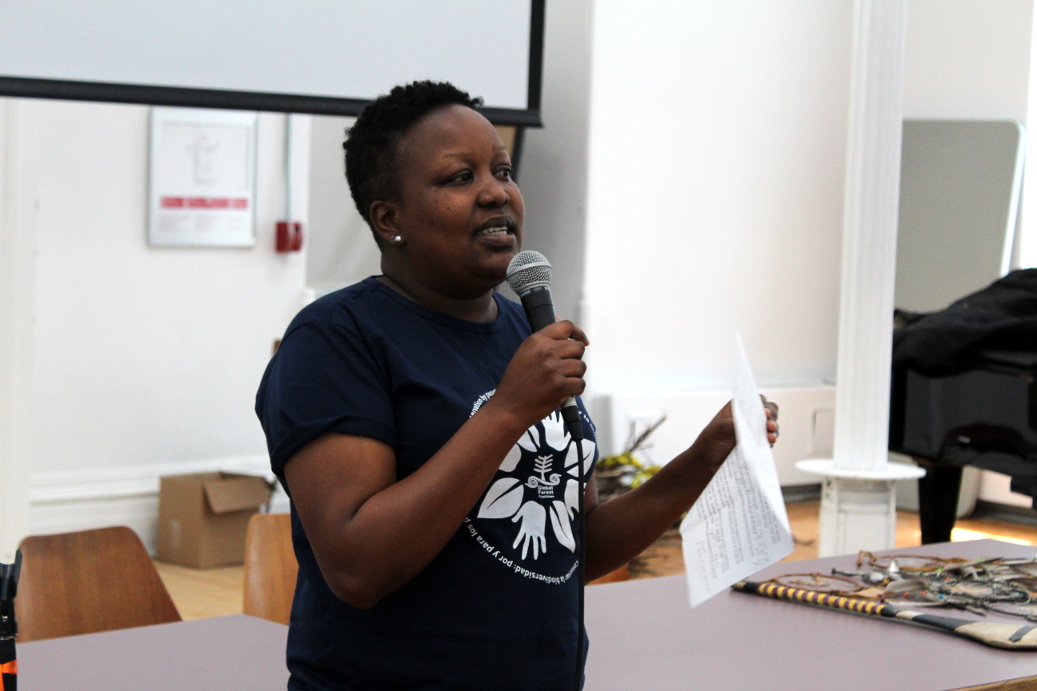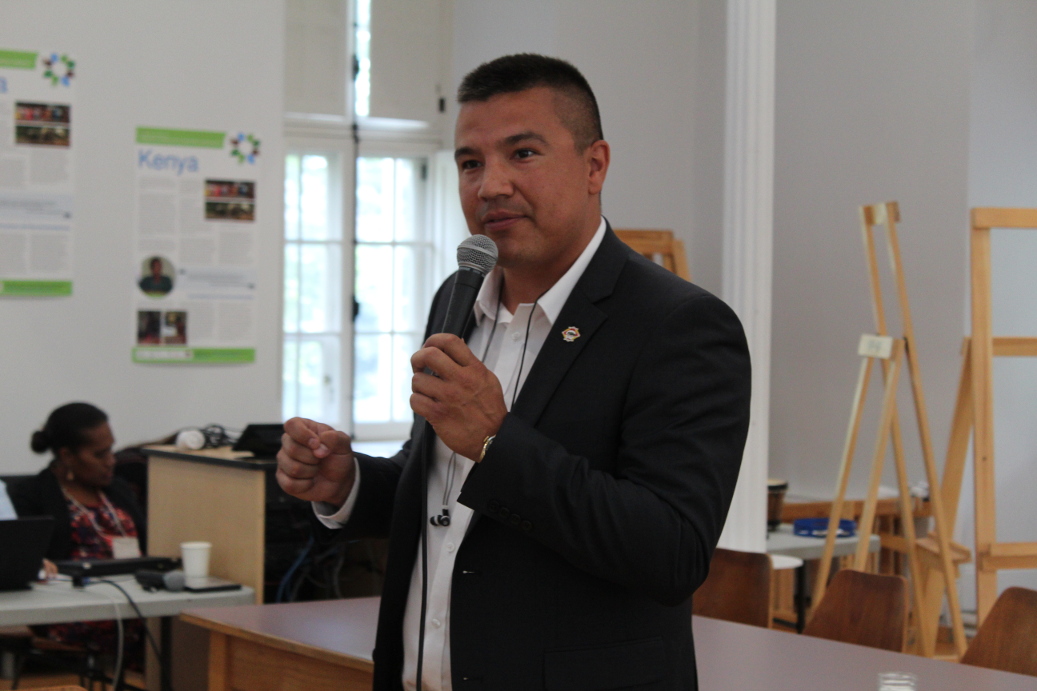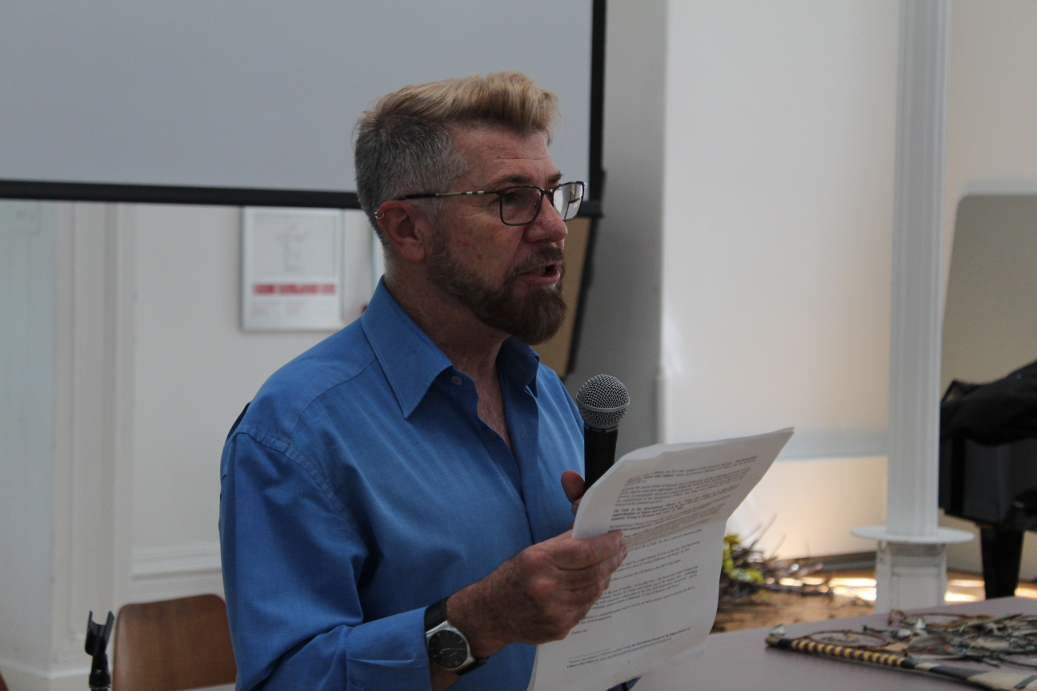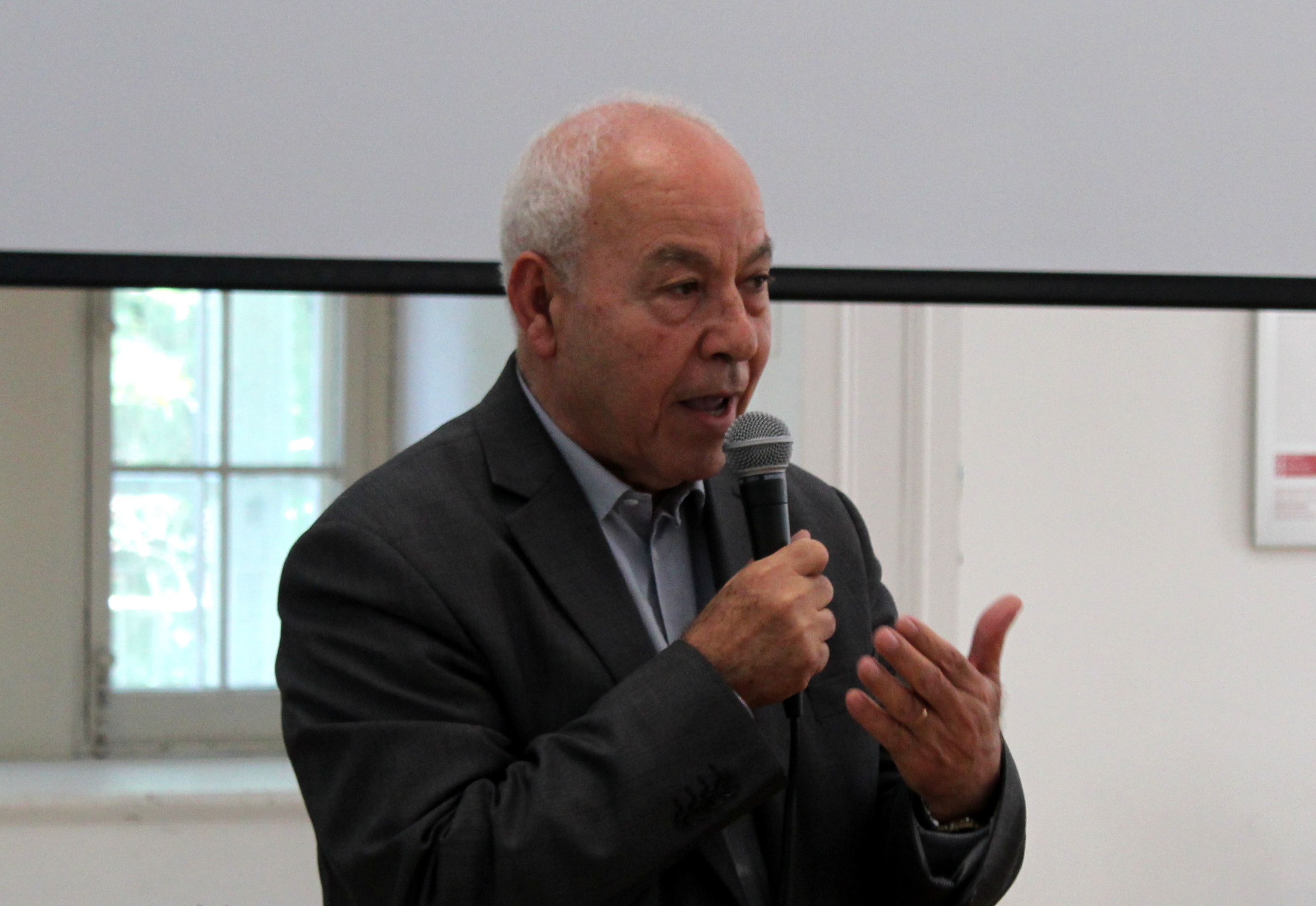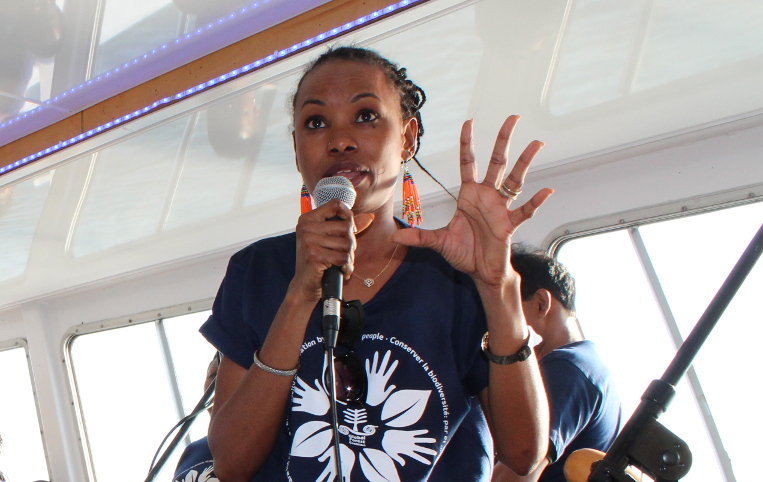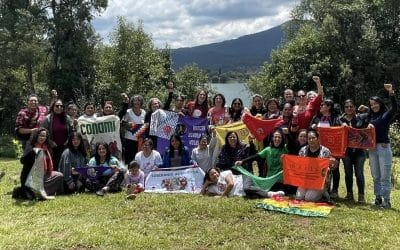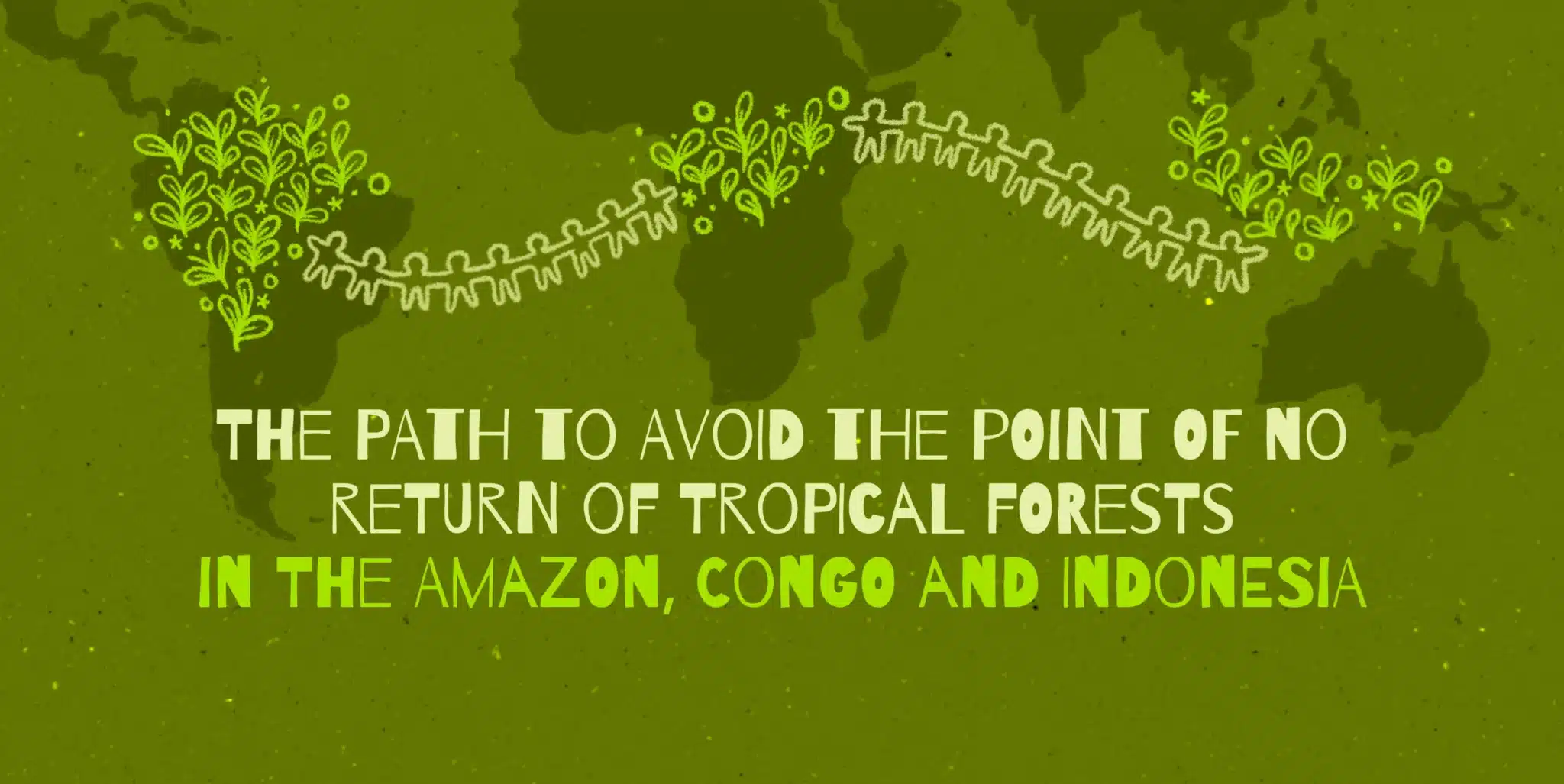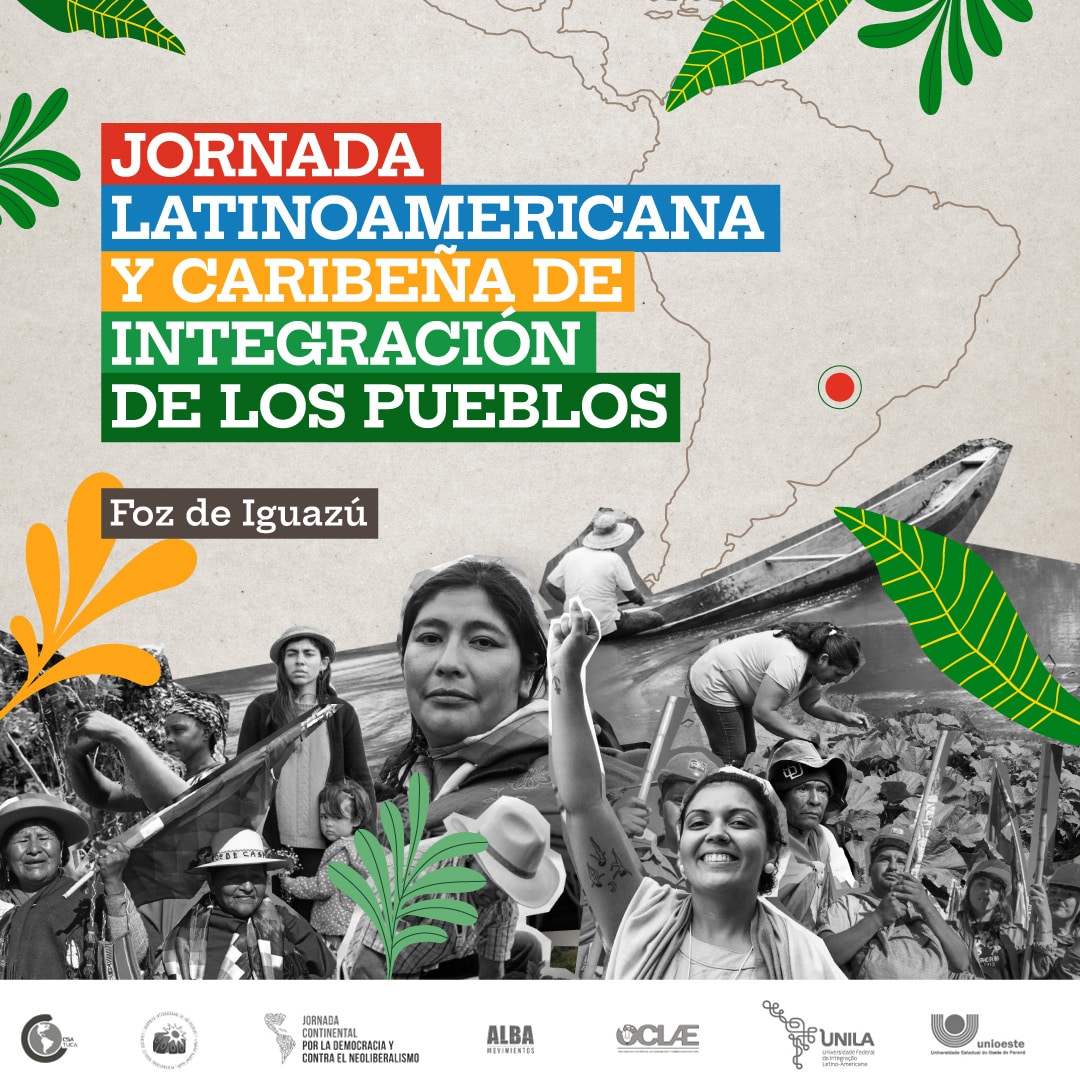Speakers, presentations and events at Fostering Community Conservation II, July 2018, Montreal
* This page works best in Firefox or Chrome, you may experience problems if using Safari.
Group photo of conference participants (top). Participants wearing the conference t-shirt (bottom left). Participants from Timberwatch, South Africa, make their message clear (bottom right).
Wednesday, 4 July
Opening ceremony
The conference kicked-off with an inspiring event that featured the voices of community activists from around the world. They showcased fantastic examples of community biodiversity restoration and conservation initiatives, and talked about the experiences and struggles that their communities are engaged in. Interwoven into this was performance, in the form of drums, poetry, dance and singing, led my Montreal-based artists.
Diego Cardona, Chairperson of the Global Forest Coalition, and Ellen Gabriel, a Mohawk activist and artist from Kanehsatake Nation, welcomed participants and delivered the first of many inspiring speeches. Other speakers and performers included: Inés Franceschelli (HENOI, Paraguay), Andrew St Ledger (Woodland League, Ireland), Dr Min Eunju (Korean Federation for Environmental Movement, South Korea), Sutej Hugu (Taiwan Indigenous Conserved Territories Union), Madina Mirakova (Noosfera, Tajikistan), Don Mario (Mapuche community, Chile), Lucy Mulenkei (Indigenous Information Network, Kenya), Ilia Kunchulia (the Greens Movement of Georgia/Zelkova, Georgia), and Aydah Vahia and Philma Noseh Zaku (NIPS, Solomon Islands), as well as Montreal-based artists Patrick Meunier, Greg Selinger, Maritza Grégoire, Jacqueline van de Geer, Claudia Bernal and Elena Stoodley.
Ellen Gabriel addresses participants (top left). Madina Mirakova describes community conservation in Tajikistan (top right). Don Mario, a representative of the Mapuche community in Chile, describes the experiences of his community (bottom left). Nazeli Vardanyan, campaigner with Armenian Forests, and Ljuba Passar, an indigenous representative of the Udege from the Russian Far East, in their traditional dress during the opening ceremony (bottom right).
Press conference
Diego Cardona (left), Chairperson of the Global Forest Coalition, Hindou Oumarou Ibrahim (left), Vice-Chairperson of the Global Forest Coalition, Simone Lovera (right), Executive Director of the Global Forest Coalition, and Aydah Vahia (right), member of the Global Forest Coalition board, laid out the case for community conservation in front of the media.
Thursday, 5 July
Mystica led by participants from Africa

Session 1: Looking at official UN biodiversity conservation policies – an introduction to the Strategic Plan for Biodiversity 2011-2020, the Sustainable Development Goals, and looking beyond to the post-2020 biodiversity framework
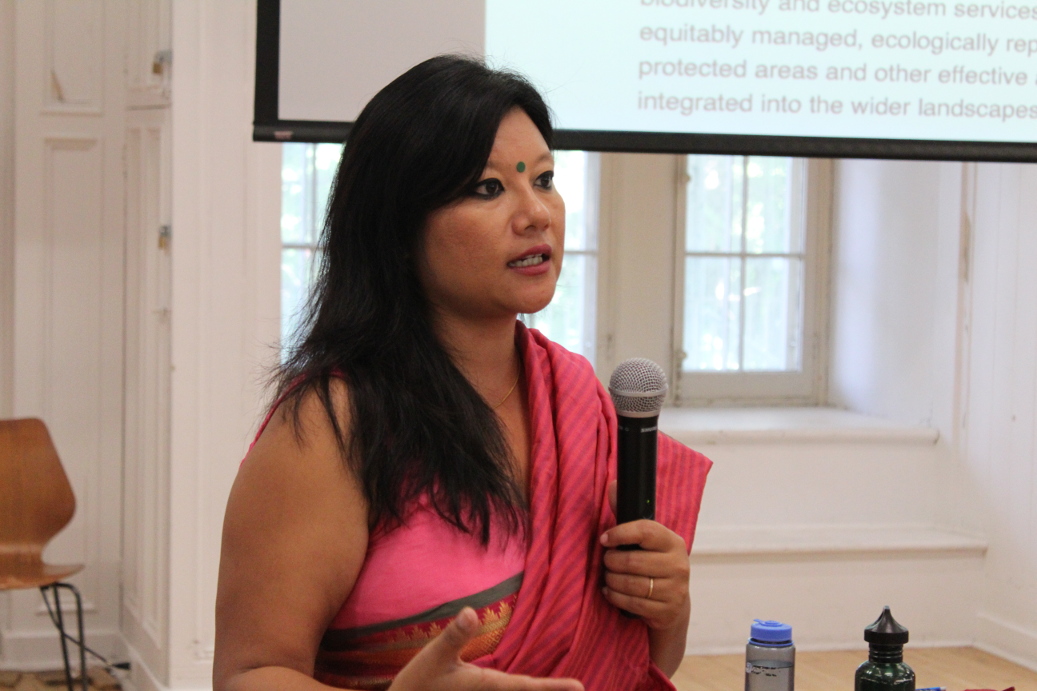
Holly Jonas (left), Global Forest Coalition and Indigenous and Community Conserved Areas (ICCA) Consortium, introduced the UN Convention on Biological Diversity (CBD) and the Strategic Plan for 2011-2020 (download Holly’s presentation), and Mrinalini Rai (right), Global Forest Coalition, spoke about community conservation and the inter-linkages between the Aichi Targets and the Sustainable Development Goals (download Mrinalini’s presentation).
Session 2: Contributions of community conservation to achieving the Strategic Plan for Biodiversity 2011-2020 and Aichi Targets
Mabel Agba (left), The Development Institute, Ghana, spoke about the opportunities and challenges of integrating community conservation into National Biodiversity Strategies and Action Plans for Biodiversity 2011-2020 in Ghana, and the challenges of mainstreaming conservation in the extractive industrial sectors (download Mabel’s presentation). Dave de Vera (right), PAFID, Philippines, Albert Chan Dzul, U Yich Lu’um and ICCA Consortium Mexico, Vololoniaina Rasoarimanana, ICCA Consortium Madagascar and Emma Courtine, Programme and communication officer for the ICCA Consortium, presented on the contributions of community conservation and ICCAs and related traditional knowledge to the Strategic Plan for Biodiversity 2011-2020 (download ICCA Consortium presentation).
Friday, 6 July
Mystica led by participants from Latin America and the Caribbean
Session 4: The CBD’s Gender Plan of Action and the contributions of women in community conservation
Tanya McGregor (left), Gender Programme Officer for the Secretariat of the CBD, described strategies for developing a gender-sensitive approach to biodiversity policy, and on the key role of women in community conservation and the mainstreaming of the CBD’s Gender Plan of Action (download Tanya’s presentation). Lucy Mulenkei (right), Indigenous Information Network and CCRI in Kenya, gave a presentation on how to integrate gender and indigenous women’s traditional knowledge and practices into the work of biodiversity conservation, taking into account the outcomes of the CCRI in Kenya (download Lucy’s presentation).
Session 5: Gender skill share
Participants split into regional groups to identify and discuss the main issues concerning gender and biodiversity in their regions.
Saturday, 7 July
Mysticas led by participants from Russian-speaking countries, and participants from Asia and the Pacific region
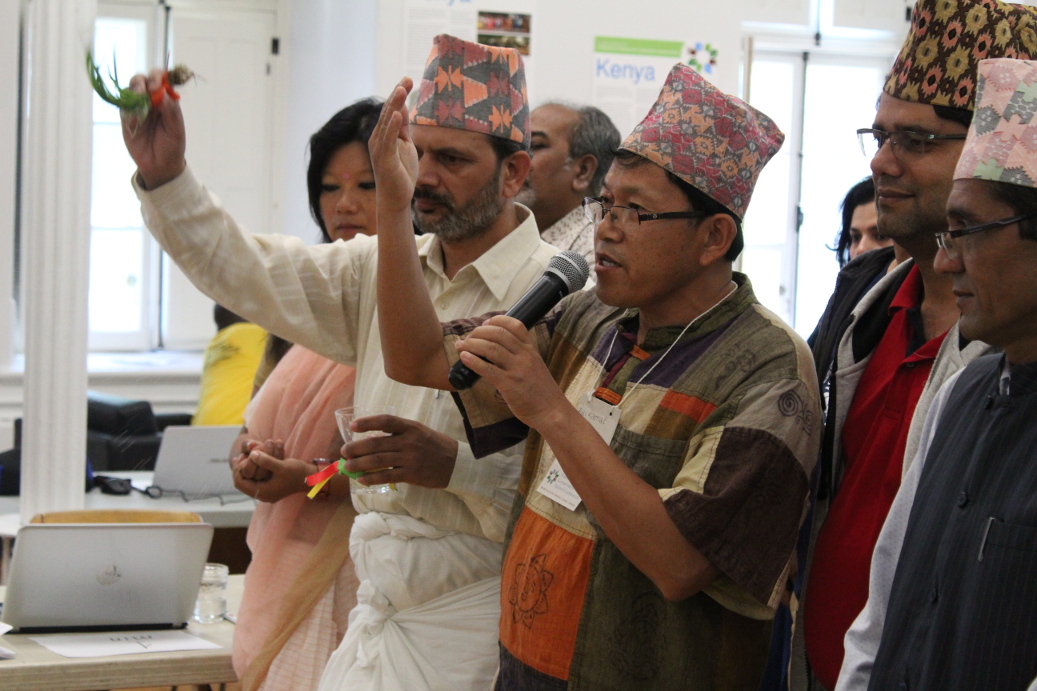
Session 6: Case studies from Community Conservation Resilience Initiative countries, looking at threats to livelihoods and customary sustainable uses of resources, and how key recommendations can be implemented
Nicolas Mukumo (top left) , PIDP-KIVU and CCRI in the Democratic Republic of Congo (DRC), spoke on the impacts of illegal logging and mining in DRC, and the violations of the rights of indigenous peoples (download Nicolas’ presentation). Avtadil Geladze and Ilia Kunchulia (top right), representing the Greens Movement of Georgia and Zelkova, presented on the traditional, sustainable management of natural resources by local communities in rural Georgia, from the perspective of the CCRI there (download Avatadil and Ilia’s presentation). Souparna Lahiri (middle left), All India Forum of Forest Movements and CCRI in India, spoke on the impacts that tree plantations have on community livelihoods (download Souparna’s presentation), and Swati Shresth (middle right), Centre for Grassroots Development, described the CCRI assessment in the Banni Grasslands, and the lives of pastoralists there (download Swati’s presentation). Perla Alvarez Britez (bottom left), CONAMURI and CCRI in Paraguay, presented on the impacts of unsustainable livestock and feedstock production in Paraguay (download Perla’s presentation). Mary Lou Malig (bottom right), Global Forest Coalition, then described the implications of international trade agreements on livestock farming and agribusiness (download Mary Lou’s presentation) and, ending the session, Oliver Munnion, Biofuelwatch, talked about the threats of the corporate take-over of biodiversity policy-making, and how this results in support for monoculture tree plantations and bioenergy projects (download Oliver’s presentation).
Session 7: A Peoples’ Pathway for biodiversity
This session involved parallel regional meetings, where participants discussed a People’s Pathway for 2030. A set of recommendations for CBD negotiators were devised (see Session 11, Mrinalini’s presentation), in order to fully incorporate community conservation into the CBD process, and to make sure that effective measures addressing the threats to community conservation are included in future CBD Strategic Plans.
Session 8: Reporting back through playback theatre
Participants reported back on the discussions and proposals debated in plenary using playback theatre. Spontaneous, non-judgemental, and respectful playback is an improvisational form of theatre where members of the audience tell their stories through actors, who play back to them on the spot through improvisation. It was a pleasure to work with Montreal-based Promito Playback Company, pictured above.
Cultural exchange for a conference gift
The final session of the day involved an exchange of cultural items, where participants were invited to swap something that they had brought from their communities for a beautiful dreamcatcher, hand-made by members of the Gros-Louis Nation.
Sunday, 8 July
Mystica led by participants from Europe and North America
Session 10: An analysis of the outcomes of CCRI case studies, looking at legal reviews and steps to implement some key recommendations
Anna Kirilenko (top left), BIOM and CCRI in Kyrgyz Republic, talked about the results of the legal review carried out through the CCRI in Kyrgyzstan (download Anna’s presentation). Fernando Salazar Ferreira (top right), Colectivo de Reservas Campesinas y Comunitarias de Santander, Fundaexpresión, and CCRI in Colombia, and Claudia Gimena Roa, Fundaexpresión, spoke on the lessons and experiences from the CCRI in their communities in Colombia. Salome Kisenge (bottom left) and Flora Muro, Envirocare and CCRI in Tanzania, described the threats to biodiversity conservation and the intricate link between community conservation practices and culture (download Envirocare’s presentation). And finally, Simone Lovera (bottom right), Global Forest Coalition, presented on the findings of the 2018 CCRI Global Report, which brought together 12 of the most recent CCRI assessments (download Simone’s presentation).
Session 11: Leaving no one behind: Community rights and biodiversity conservation post-2020
This session saw a number of inspiring presentations and speeches by a wide-range of actors involved in community rights and biodiversity conservation, including: Mrinalini Rai, Global Forest Coalition, who summarised the outcomes of the People’s Pathway for biodiversity discussions from the previous day (download Mrinalini’s presentation); Andreas Obrecht, Programme Management Officer for the Law Division of UN Environment (download Andreas’ presentation); Claudia Ituarte-Lima (top left), researcher at the Stockholm Resilience Centre and Advisor at SwedBio (download Claudia’s presentation); Edna Kaptoyo (top right), coordinator of the International Alliance of Tribal and Indigenous Peoples of the Tropical Forest, Kenya; Leel Randeni, Nirmanee Development Foundation, Sri Lanka (download Leel’s presentation); Aydah Vahia (bottom left), coordinator of the Network of Indigenous Peoples of the Solomon Islands (download Aydah’s presentation); and Chief Constant Awashish (bottom right), Grand Chief of Atikamekw Nation, Canada.
Session 11: Closing Session
The Fostering Community Conservation II conference saw John Scott (left), Senior Programme Officer for Traditional Knowledge to the Secretariat of the CBD, talk about “re-imagining conservation”, in particular regard to the positioning of Indigenous Peoples and Local Communities, and a rapprochement of nature and cultures in the Post 2020 Biodiversity Framework. Professor Hamdallah Zedan (right), National Focal Point for the Egyptian Presidency to the 14th Conference of the Parties of the CBD, closed proceedings with a presentation on community conservation in Africa, and the road to the CBD’s COP14.
Closing Event
The final keynote speech of the conference was delivered on a boat in the Hudson River by Hindou Oumarou Ibrahim, Vice-Chairperson of the Global Forest Coalition and AFPAT, Chad. Hindou spoke passionately about how the rights and knowledge of Indigenous Peoples must form the basis of conservation efforts.

